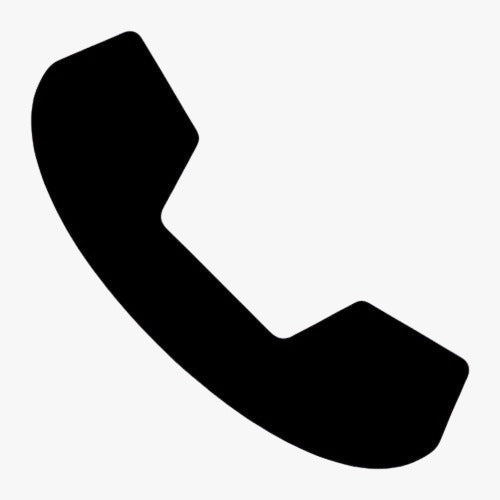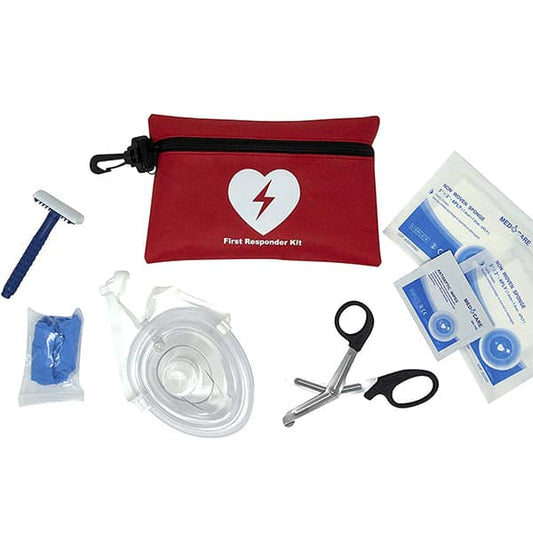
Empowering anyone, anywhere to confidently protect life and take action in any emergency
We offer a wide range of Automated External Defibrillators (AEDs), batteries, pads, accessories, first aid and bleed kits. We also provide expert recommendations, training, and maintenance programs to ensure you're prepared for any emergencies.

Flexible AED Rentals — Protection Without the Upfront Cost
Get life-saving AEDs on affordable rental plans starting at just $1.50/day. Each plan includes pads, batteries, maintenance, and full compliance support — no hidden fees, no hassle. Stay prepared, budget-friendly.

Be Ready for Any Emergency — Anywhere, Anytime
From bleeding control kits to complete trauma packs, our first aid solutions give you the confidence to respond instantly. Trusted by schools, offices, and safety professionals nationwide.

Train to Save Lives — Get Certified in CPR & AED Use
Empower your team with hands-on CPR and AED training led by certified instructors. Gain the skills and confidence to take action when every second counts. Group and onsite sessions available.
DECEMBER DEALS
-

Heartsine Samaritan 350P AED Package
<div class="tab-contents"> <h2><strong>Unlock Safety with the HeartSine Samaritan 350P AED Complete Bundle</strong></h2> <p><em>Experience Confidence with:</em></p> <ul> <li>New HeartSine Samaritan 350P AED</li> <li>Carry Case</li> <li>8-Year Warranty</li> <li>User Manual</li> <li>Pads & Battery (Pre-Installed)</li> <li>AED Wall Cabinet</li> <li>First Responder Kit*</li> <li>AED 3-Way Sign</li> <li>AED Wall Poster</li> <li>AED Inspection Card (I-Tag)</li> <li>“AED On-Site” Window Decal (AEDecal)</li> <li>Free Shipping</li> </ul> <p><em>The First Responder Kit features vital first-aid tools: two towelettes, scissors, a razor, a pair of nitrile gloves, and a pocket CPR mask, neatly arranged in a zippered nylon pouch.</em></p> <h3>Elevate Safety with the HeartSine Samaritan 350P AED:</h3> <ul> <li> <strong>Compact and User-Friendly:</strong> <ul> <li>Tailored for lay responders, lightweight, and easy to use.</li> <li>Ideal complement for workplaces, schools, or manufacturing facilities.</li> </ul> </li> <li> <strong>Efficiency at its Core:</strong> <ul> <li>Smallest and lightest AED available, weighing just 2.4 lbs.</li> <li>Boasts the highest durability ratings, including an IP56 Dust & Water Rating and Military Standard Drop Test.</li> </ul> </li> <li> <strong>Authorized Distributor:</strong> <ul> <li>Trust Response Ready, your reliable source for HeartSine AED Defibrillators.</li> </ul> </li> </ul> <p><strong>Explore Additional <a href="https://responseready.com/collections/heartsine-value-packages">HeartSine AED Packages</a></strong> for diverse models and tailored solutions. Choose Response Ready for unmatched AED excellence.</p> <p><em>Alternate Part Numbers: PAD 350P, PAD 300P, PAD-BAS-US-05, PAD-SYS-US-05, PAD-PED-US-05, PAD-TRN-US-05, SAM 300-P, SAM 300P-1, SAM 300P-2</em></p> </div>
Heartsine Samaritan 350P AED Package
view productRegular price $1,461.60Regular priceUnit price / per$200 OFF - Code: HEARTSINE200
-

Physio-Control LIFEPAK CR2 Value Package
<div class="tab-contents"> <div align="justify"> <h2><strong>Elevate Your AED Program with the Response Ready LIFEPAK CR2 Value Package</strong></h2> <p>Unlock the potential of automated external defibrillation with the cutting-edge <a href="https://responseready.com/products/physio-control-lifepak-cr2">LIFEPAK CR2</a> from Stryker, available in both semi- and fully automatic editions. Response Ready presents the LIFEPAK CR2 Value Package, bundling the AED with essential accessories at an unbeatable price.</p> <p><strong>What’s Included:</strong></p> <ul> <li>New Physio-Control LIFEPAK CR2 AED</li> <li>Carry Case or Handle</li> <li>8-Year Warranty</li> <li>User Manual</li> <li>Pads & Battery (Pre-Installed)</li> <li>AED Wall Cabinet</li> <li>First Responder Kit*</li> <li>AED 3-Way Sign</li> <li>AED Wall Poster</li> <li>AED Inspection Card (I-Tag)</li> <li>“AED On-Site” Window Decal (AEDecal)</li> </ul> <p>*The First Responder Kit comprises first-aid essentials in a convenient zippered nylon pouch: two towelettes, scissors, a razor, a pair of nitrile gloves, and a pocket CPR mask.</p> <h2><strong>Effortless Operation for Lay Responders</strong></h2> <p>The LIFEPAK CR2 is designed for ease of use, especially for those with minimal training:</p> <ul> <li>Audible coaching guides users through CPR and defibrillation.</li> <li>The metronome aids in performing CPR with professional precision.</li> <li>ClearVoice™ Technology ensures audible coaching in various environments, adjusting volume based on ambient noise.</li> </ul> <p><strong>Semi- and Fully Automatic Models</strong></p> <p>Choose the model that suits your needs:</p> <ul> <li>Semi-automatic model with a “Shock” button for manual intervention.</li> <li>Fully automatic model for hands-free defibrillation, eliminating user anxiety.</li> </ul> <p><strong>Rugged and Versatile Design</strong></p> <p>The LIFEPAK CR2 excels in durability and versatility:</p> <ul> <li>Compact and lightweight with an IP55 rating for dust and water resistance.</li> <li>cprINSIGHT™ Analysis allows uninterrupted CPR during heart rhythm analysis.</li> <li>Child and optional bilingual modes enhance usability.</li> </ul> <h2><strong>Why Choose Response Ready?</strong></h2> <p>As an authorized distributor of Stryker and <a href="https://responseready.com/collections/physio-control">Physio-Control AEDs</a>, Response Ready offers:</p> <ul> <li>Free shipping for the LIFEPAK CR2 Value Package.</li> <li>30-day return policy for added peace of mind.</li> <li>One-year low-price guarantee, ensuring the best value.</li> </ul> <p><strong>Order Your Physio-Control LIFEPAK CR2 Value Package Today</strong></p> <p>Invest in the future of AED programs with Response Ready. Order the LIFEPAK CR2 Value Package and equip your facility with state-of-the-art lifesaving technology.</p> </div> </div>
Physio-Control LIFEPAK CR2 Value Package
view productRegular price From $2,376.90Regular priceUnit price / per$400 OFF - Code: CR2400
-

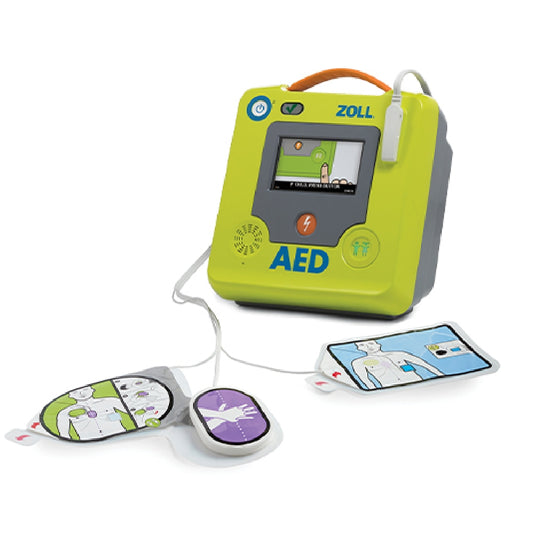
ZOLL AED 3
<h2><strong>Elevate Your Rescue Capabilities with the ZOLL AED 3 from Response Ready</strong></h2> <p>Unleash the power of the ZOLL AED 3, the latest in life-saving technology, available exclusively from Response Ready—the premier distributor of FDA-approved automated external defibrillators in the USA.</p> <p><strong>What's Included:</strong></p> <ul> <li>New ZOLL AED 3 defibrillator</li> <li>7-Year Warranty</li> <li>User Manual</li> <li>Pre-Installed Pads & Battery</li> <li>First Responder Kit</li> <li>AED Inspection Card (I-Tag)</li> <li>“AED On-Site” Window Decal (AEDecal)</li> <li>Free Shipping</li> </ul> <p><em>Complimentary accessories valued at over $50 accompany this AED purchase.</em></p> <p><strong>ZOLL AED 3 Overview</strong></p> <p>Designed to excel in both professional and lay rescuer settings, the ZOLL AED 3 is equipped to tackle challenging environments. Key features include:</p> <ul> <li>High-resolution LCD display</li> <li>Instant feedback on CPR chest compression rate and depth</li> <li>Resistance to dust, high pressure, and direct water spray</li> <li>Available in semi-automatic or fully-automatic + manual override configurations</li> </ul> <p><em>Recognitions:</em><br>Winner of the Occupational Health & Safety New Product of the Year award and the 5 Star Winner of the World of Safety & Health Award in 2020.</p> <p><strong>Key Features of ZOLL AED 3</strong></p> <ol> <li> <strong>Enhanced Real CPR Help:</strong> ZOLL's Real CPR Help technology provides optimal life-saving resuscitation. The full-color display includes images, a CPR timer, and a depth gauge.</li> <li> <strong>Integrated Pediatric Rescue:</strong> CPR Uni-padz® electrodes offer a universal solution for both adult and pediatric victims.</li> <li> <strong>WiFi Connectivity:</strong> Cloud connectivity enables automatic reporting of device status and swift access to transmit cardiac arrest event data to medical professionals.</li> </ol> <p><strong>Why Choose Response Ready?</strong></p> <p>AED Leader is now Response Ready—the sole AUTHORIZED online distributor of <a href="/collections/zoll-aed-defibrillators">ZOLL AED devices</a>.</p> <p><em>Alternate Part Numbers:</em> 90110200499991010, 90110600499991010<a href="https://responseready.com/wp-content/uploads/2024/02/ZOLL-AED-3-User-Manual.pdf"></a></p>
ZOLL AED 3
view productRegular price $2,307.00Regular priceUnit price / per$225 OFF - Code: Z3225
-

Heartsine Samaritan PAD 450P AED Package
<div class="tab-contents"> <h2><strong>Experience Lifesaving Excellence with the HeartSine Samaritan PAD 450P AED Complete Package</strong></h2> <p><em>Unbox Confidence with:</em></p> <ul> <li>New HeartSine Samaritan PAD 450P AED</li> <li>Carry Case</li> <li>8-Year Warranty</li> <li>User Manual</li> <li>Pads & Battery (Pre-Installed)</li> <li>AED Wall Cabinet</li> <li>First Responder Kit*</li> <li>AED 3-Way Sign</li> <li>AED Wall Poster</li> <li>AED Inspection Card (I-Tag)</li> <li>“AED On-Site” Window Decal (AEDecal)</li> <li>Free Shipping</li> </ul> <p><em>The First Responder Kit includes essential first-aid items: two towelettes, scissors, a razor, a pair of nitrile gloves, and a pocket CPR mask, organized in a convenient zippered nylon pouch.</em></p> <h2>Why Choose the HeartSine Samaritan PAD 450P AED?</h2> <ul> <li> <strong>Integrated CPR Rate Advisor:</strong> <ul> <li>Exclusive feature providing live CPR rate feedback.</li> <li>Audible and visual guidance for proper compression rate without accelerometers.</li> <li>Real-time CPR rate gauge for visual confirmation during compressions.</li> </ul> </li> <li> <strong>Enhanced Lifesaving Experience:</strong> <ul> <li>Builds upon the features of the renowned 350P model.</li> <li>Smallest, lightest, and most durable AED, now with integrated CPR guidance.</li> </ul> </li> <li> <strong>User-Friendly CPR Feedback:</strong> <ul> <li>Announces if compression adjustments are needed: push faster, push slower, or "good speed."</li> <li>Real-time visual guidance for compression rate without special electrodes.</li> </ul> </li> <li> <strong>Universal Compatibility:</strong> <ul> <li>Utilizes the same Pad-Pak adult electrodes/battery combination as the 350P model.</li> <li>Simplifies maintenance and ensures compatibility with existing accessories.</li> </ul> </li> </ul> <p><strong>Response Ready is Your Authorized Distributor for HeartSine AED Defibrillators. Order Yours Today!</strong></p> <p>Explore other <a href="https://responseready.com/collections/heartsine-value-packages">HeartSine AED Packages</a> for additional models and options. Elevate your response with Response Ready.</p> </div>
Heartsine Samaritan PAD 450P AED Package
view productRegular price $1,811.60Regular priceUnit price / per$200 OFF - Code: HEARTSINE200
-
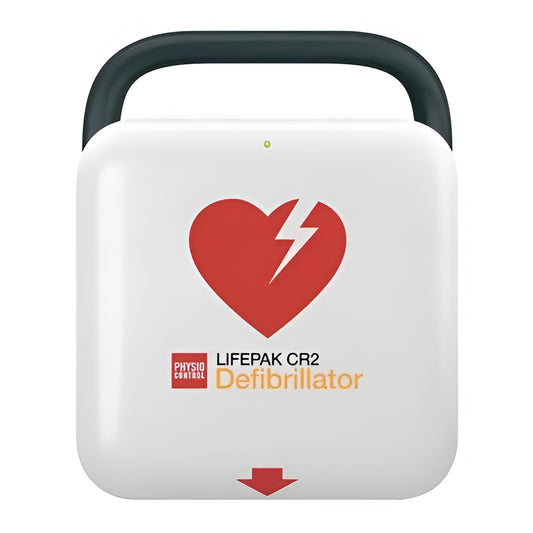
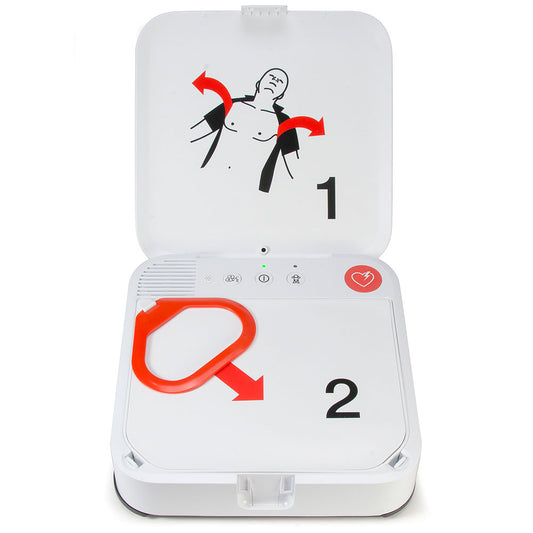
Physio Control Lifepak CR2
<h2><strong>Elevate Cardiac Emergency Response with the Response Ready LIFEPAK CR2 AED</strong></h2> <p><em>Comprehensive Package:</em></p> <ul> <li>New Physio-Control LIFEPAK CR2 AED</li> <li>Carry Case or Handle</li> <li>8-Year Warranty</li> <li>User Manual</li> <li>Pads & Battery (Pre-Installed)</li> <li>First Responder Kit</li> <li>AED Inspection Card (I-Tag)</li> <li>“AED On-Site” Window Decal (AEDecal)</li> <li>Free Shipping</li> </ul> <p><em>Complimentary Accessories:</em></p> <ul> <li>Accessories valued over $50 included with the AED.</li> </ul> <h3>Advanced Features for Effortless Lifesaving:</h3> <ol> <li> <em>Simple, Streamlined Design:</em> <ul> <li>Clearly labeled buttons and bold diagrams for easy operation by users of all experience levels.</li> </ul> </li> <li> <em>Voice Coaching:</em> <ul> <li>Audible coaching guides users through CPR and treatment.</li> <li>Built-in metronome ensures optimal chest compression pace.</li> </ul> </li> <li> <em>Rugged Build:</em> <ul> <li>Boasts an IP55 rating for high resistance against dust and water penetration.</li> </ul> </li> <li> <em>cprINSIGHT™ Analysis:</em> <ul> <li>First in the industry to allow chest compressions during ECG analysis.</li> <li>Increases hands-on time and reduces pauses in CPR for improved survival outcomes.</li> </ul> </li> <li> <em>LIFELINKcentral:</em> <ul> <li>Connects via WiFi for remote monitoring and management of device readiness.</li> <li>Provides near-real-time email alerts for pad placement and device use.</li> </ul> </li> <li> <em>ClearVoice™ Technology:</em> <ul> <li>Volume adjusts based on background noise for clear instructions in any environment.</li> </ul> </li> <li> <em>Child Mode:</em> <ul> <li>Reduces defibrillation energy for pediatric patients using the same electrodes.</li> </ul> </li> <li> <em>Bilingual Functionality:</em> <ul> <li>Optional bilingual feature for instructions in a second pre-set language.</li> </ul> </li> <li> <em>Emergency Services Support:</em> <ul> <li>Sends real-time information to receiving hospitals via Wi-Fi, including heart rhythm and shocks delivered.</li> </ul> </li> </ol> <p><strong>Trust in Response Ready:</strong></p> <ul> <li>Authorized distributor of <a href="https://responseready.com/collections/physio-control-defibrillators">Physio-Control defibrillators</a>.</li> <li>Free shipping and a one-year low-price guarantee for an unbeatable deal.</li> </ul> <p><em>Order Your LIFEPAK CR2 AED Today for Enhanced Cardiac Emergency Preparedness.</em></p> <p><em>Alternate Part Number: 80427-000135</em></p>
Physio Control Lifepak CR2
view productRegular price From $2,256.00Regular priceUnit price / per$400 OFF - Code: CR2400
-


ZOLL AED Plus (Semi Automatic)
<h2><strong>Enhance Emergency Preparedness with the ZOLL AED Plus from Response Ready</strong></h2> <p>Invest in the ZOLL AED Plus, an advanced defibrillator specifically designed for easy use by lay rescuers. As a trusted name in the AED industry for over 25 years, ZOLL brings you a powerful, user-friendly device to empower quick and effective response in critical situations.</p> <p><strong>Package Contents:</strong></p> <ul> <li>New ZOLL AED Plus defibrillator</li> <li>Carry Case</li> <li>7-Year Warranty</li> <li>User Manual</li> <li>Pre-Installed Pads & Battery</li> <li>First Responder Kit</li> <li>AED Inspection Card (I-Tag)</li> <li>“AED On-Site” Window Decal (AEDecal)</li> </ul> <p><em>Complimentary accessories included, valued at over $50.</em></p> <p><strong>Key Features for Lay Rescuers:</strong></p> <ul> <li> <strong>Real-Time CPR Help:</strong> Provides immediate audio and visual prompts assessing the rate and depth of chest compressions, guiding the rescuer for optimal performance.</li> <li> <strong>Easy-to-Place Pads:</strong> Pre-connected pads with intuitive alignment, ensuring correct placement with ease.</li> <li> <strong>Child-Friendly Design:</strong> Compatible with ZOLL Pedi Padz II (sold separately) for pediatric use, automatically adjusting coaching and treatment.</li> </ul> <p><strong>Readiness at a Glance:</strong></p> <ul> <li> <strong>Automated Self-Tests:</strong> Daily, weekly, and monthly self-tests for constant readiness.</li> <li> <strong>Long Battery and Pad Lifespan:</strong> Lithium batteries and CPR-D-padz with a 5-year lifespan, backed by an industry-leading 7-year warranty.</li> </ul> <p><strong>Automatic Options for Simplicity:</strong></p> <ul> <li>Choose the fully automatic version for hands-free operation, providing a shock without user intervention.</li> </ul> <p><strong>Rugged Reliability:</strong></p> <ul> <li> <strong>Built to Endure:</strong> Withstands extreme conditions—freezing or scorching temperatures, high altitudes, and shock.</li> <li> <strong>IP55 Rating:</strong> Certified against dust and water for added durability.</li> <li> <strong>Compact and Lightweight:</strong> Ideal for various settings such as offices, schools, churches, hotels, gyms, and high-traffic locations.</li> </ul> <p><strong>Product Specifications:</strong></p> <ul> <li>Size: 5.25″ x 9.50″ x 11.50″ (13.3 cm x 24.1 cm x 29.2 cm)</li> <li>Weight: 6.7 lbs; 3.1 kg</li> </ul> <p><strong>Order Your ZOLL AED Plus from Response Ready:</strong> Ensure a user-friendly and reliable AED is at your fingertips. Purchase the ZOLL AED Plus from Response Ready today and benefit from free shipping along with our one-year low-price guarantee.</p> <p><em>Explore wholesale pricing options for large quantity orders on our <a href="https://responseready.com/pages/wholesale-aeds/">wholesale page</a>.</em></p> <div class="tab-contents"> <div style="float: left; width: 49%;"> <h3>ZOLL AED Plus Video Overview</h3> <p><iframe height="315" width="560" src="https://www.youtube.com/embed/KjvcBU35j9k"></iframe></p> </div> <div style="float: right; width: 49%;"> <h3>How to Use the ZOLL AED Plus</h3> <p><iframe height="315" width="560" src="https://www.youtube.com/embed/EHX-RiJ8EbM"></iframe></p> </div> </div>
ZOLL AED Plus (Semi Automatic)
view productRegular price $2,082.00Regular priceUnit price / per$450 OFF - Code: ZPLUS450
CATEGORIES WE PROVIDE
-

AED Packages
Elevate Safety with Response Ready's Comprehensive AED Packages Discover a range of...
-

AED Accessories
Response Ready: Elevate Your AED Experience Welcome to Response Ready, your trusted...
-

AED Batteries
Energize with Response Ready AED Batteries Power up your defibrillator with the...
-

Trainer Devices
Enhance CPR and AED training with response ready AED trainers Welcome to...
BEST AED PACKAGES
-

Philips HeartStart OnSite AED Value Package
<h2><strong>Empower Your Response with the Philips HeartStart OnSite AED Complete Package</strong></h2> <p><em>Unbox Life-Saving Confidence with:</em></p> <ul> <li>New Philips HeartStart OnSite AED</li> <li>Carry Case</li> <li>8-Year Warranty</li> <li>User Manual</li> <li>Pads & Battery (Pre-Installed)</li> <li>AED Wall Cabinet</li> <li>First Responder Kit*</li> <li>AED 3-Way Sign</li> <li>AED Wall Poster</li> <li>AED Inspection Card (I-Tag)</li> <li>“AED On-Site” Window Decal (AEDecal)</li> <li>Free Shipping</li> </ul> <p><em>The First Responder Kit contains essential first-aid items: two towelettes, scissors, a razor, a pair of nitrile gloves, and a pocket CPR mask, neatly organized in a zippered nylon pouch.</em></p> <h2>Why Choose the Philips HeartStart OnSite AED?</h2> <ul> <li> <strong>Guided Emergency Response:</strong> <ul> <li>Intuitive design with audible voice commands for easy step-by-step guidance.</li> <li>Clear instructions on CPR, pad application, and defibrillation.</li> <li>Automatic assessment of the heart rhythm for precise guidance.</li> </ul> </li> <li> <strong>Versatile Training Capability:</strong> <ul> <li>Doubles as a training device with a separate <a href="/product/onsite-adult-training-cartridge/">OnSite training cartridge</a> (sold separately).</li> <li>Access helpful demonstration videos for comprehensive emergency preparedness.</li> </ul> </li> <li> <strong>Ready-to-Use Convenience:</strong> <ul> <li>OnSite Ready-Pack configuration for instant use with no assembly required.</li> <li>SMART Pads and battery pre-installed for immediate deployment.</li> <li>Spare set of pads stored for future use.</li> </ul> </li> <li> <strong>Automated Readiness Assurance:</strong> <ul> <li>Conducts 85 automatic self-tests monthly for internal hardware, battery, and pads.</li> <li>Quick and reliable response, ensuring readiness when every second counts.</li> </ul> </li> </ul> <p><strong>Order Your Philips HeartStart OnSite AED Package Today for a Complete Lifesaving Solution.</strong></p> <p>Explore other <a href="https://responseready.com/collections/philips">Philips AED Packages</a> for a variety of automated external defibrillator options. Elevate your emergency response with Response Ready.</p>
Philips HeartStart OnSite AED Value Package
view productRegular price From $1,579.00Regular priceUnit price / per$200 OFF - Code: ONSITE200
-

Heartsine Samaritan 350P AED Package
<div class="tab-contents"> <h2><strong>Unlock Safety with the HeartSine Samaritan 350P AED Complete Bundle</strong></h2> <p><em>Experience Confidence with:</em></p> <ul> <li>New HeartSine Samaritan 350P AED</li> <li>Carry Case</li> <li>8-Year Warranty</li> <li>User Manual</li> <li>Pads & Battery (Pre-Installed)</li> <li>AED Wall Cabinet</li> <li>First Responder Kit*</li> <li>AED 3-Way Sign</li> <li>AED Wall Poster</li> <li>AED Inspection Card (I-Tag)</li> <li>“AED On-Site” Window Decal (AEDecal)</li> <li>Free Shipping</li> </ul> <p><em>The First Responder Kit features vital first-aid tools: two towelettes, scissors, a razor, a pair of nitrile gloves, and a pocket CPR mask, neatly arranged in a zippered nylon pouch.</em></p> <h3>Elevate Safety with the HeartSine Samaritan 350P AED:</h3> <ul> <li> <strong>Compact and User-Friendly:</strong> <ul> <li>Tailored for lay responders, lightweight, and easy to use.</li> <li>Ideal complement for workplaces, schools, or manufacturing facilities.</li> </ul> </li> <li> <strong>Efficiency at its Core:</strong> <ul> <li>Smallest and lightest AED available, weighing just 2.4 lbs.</li> <li>Boasts the highest durability ratings, including an IP56 Dust & Water Rating and Military Standard Drop Test.</li> </ul> </li> <li> <strong>Authorized Distributor:</strong> <ul> <li>Trust Response Ready, your reliable source for HeartSine AED Defibrillators.</li> </ul> </li> </ul> <p><strong>Explore Additional <a href="https://responseready.com/collections/heartsine-value-packages">HeartSine AED Packages</a></strong> for diverse models and tailored solutions. Choose Response Ready for unmatched AED excellence.</p> <p><em>Alternate Part Numbers: PAD 350P, PAD 300P, PAD-BAS-US-05, PAD-SYS-US-05, PAD-PED-US-05, PAD-TRN-US-05, SAM 300-P, SAM 300P-1, SAM 300P-2</em></p> </div>
Heartsine Samaritan 350P AED Package
view productRegular price $1,461.60Regular priceUnit price / per$200 OFF - Code: HEARTSINE200
-
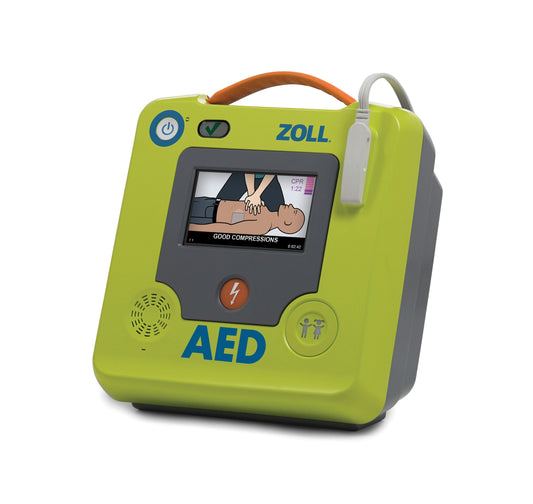
Zoll AED 3 Value Package
<h2><strong>Enhance Life-Saving Readiness with the Response Ready ZOLL AED Plus Package</strong></h2> <p><em>Complete Package:</em></p> <ul> <li>New ZOLL AED Plus</li> <li>Carry Case</li> <li>7-Year Warranty</li> <li>User Manual</li> <li>Pads & Battery (Pre-Installed)</li> <li>AED Wall Cabinet</li> <li>First Responder Kit*</li> <li>AED 3-Way Sign</li> <li>AED Wall Poster</li> <li>AED Inspection Card (I-Tag)</li> <li>“AED On-Site” Window Decal (AEDecal)</li> <li>Free Shipping</li> </ul> <p>*First Responder Kit includes towelettes, scissors, razors, nitrile gloves, and a pocket CPR mask in a zippered nylon pouch.</p> <h3>Customizable Options for Your Needs:</h3> <ol> <li> <em>AED Variants:</em> <ul> <li>Available in both semi-automatic and automatic versions.</li> <li>Semi-automatic version prompts the user to press a “Shock” button.</li> <li>Fully automatic version (additional cost) delivers shock automatically.</li> </ul> </li> <li> <em>Cabinet Upgrade:</em> <ul> <li>Upgrade the standard cabinet for enhanced security.</li> <li>Options include cabinets with alarms and/or strobe lights.</li> </ul> </li> <li> <em>Optional Add-Ons:</em> <ul> <li>Bleeding control kit available to prevent traumatic blood loss.</li> </ul> </li> </ol> <h3>Order from Response Ready:</h3> <ul> <li>Authorized ZOLL distributor, ensuring authenticity.</li> <li>Customizable packages to meet specific requirements.</li> </ul> <p><em>Explore our range of <a href="/product-category/value-packages/">AED packages</a> for other defibrillator models.</em></p> <h3>ZOLL AED Plus Device Highlights:</h3> <ol> <li> <em>Audible and Visual Coaching:</em> <ul> <li>Calm, clear voice coaching for ease of use by lay responders.</li> <li>Large rescue graphics for visual context in noisy environments.</li> </ul> </li> <li> <em>Intuitive CPR Feedback:</em> <ul> <li>Real-time instruction and feedback during CPR.</li> <li>CPR Bar Gauge for compression depth and rate guidance.</li> </ul> </li> <li> <em>One-Piece Electrode Pads:</em> <ul> <li> <a href="/product/zoll-cpr-d-padz/">ZOLL CPR-D-padz</a> for easy application.</li> <li>Simplified placement with a single frame design.</li> </ul> </li> <li> <em>Rugged Design:</em> <ul> <li>IP55 rating for dust and water protection.</li> <li>Meets military standards for shock and vibration resistance.</li> <li>Suitable for use in boats and aircraft.</li> </ul> </li> </ol> <p><em>Order your ZOLL AED Plus Package from Response Ready for unparalleled life-saving capabilities.</em></p> <div style="float: left; width: 49%;"> <h4>ZOLL AED Plus Overview</h4> <p><iframe src="https://www.youtube.com/embed/KjvcBU35j9k" width="560" height="315" frameborder="0" allowfullscreen="allowfullscreen"></iframe></p> <p> </p> </div> <div style="float: right; width: 49%;"> <h4>ZOLL AED Plus Training Video</h4> <p><iframe src="https://www.youtube.com/embed/EHX-RiJ8EbM" width="560" height="315" frameborder="0" allowfullscreen="allowfullscreen"></iframe></p> </div>
Zoll AED 3 Value Package
view productRegular price $2,367.50Regular priceUnit price / per -

Defibtech Lifeline AED Package
<div class="whats-included"> <h2><strong>Elevate Response Readiness with the Response Ready Lifeline AED Package</strong></h2> <p><em>Unlock the Power of Preparedness:</em></p> <ul> <li>New Defibtech Lifeline AED</li> <li>Carry Case</li> <li>8-Year Warranty</li> <li>User Manual</li> <li>Pads & Battery (Pre-Installed)</li> <li>AED Wall Cabinet</li> <li>First Responder Kit*</li> <li>AED 3-Way Sign</li> <li>AED Wall Poster</li> <li>AED Inspection Card (I-Tag)</li> <li>“AED On-Site” Window Decal (AEDecal)</li> <li>Free Shipping</li> </ul> <p><em>The First Responder Kit: Essential first-aid tools - two towelettes, scissors, a razor, a pair of nitrile gloves, and a pocket CPR mask, housed in a zippered nylon pouch.</em></p> <h3>Order Your Response Ready Lifeline AED Package</h3> <p><em>Unmatched Defibrillation Excellence:</em></p> <ul> <li>Powerful Lifeline AED designed for ease of use and durability.</li> <li>Perfect for offices, schools, churches, hotels, and high-traffic environments.</li> </ul> <p><strong>What Sets Us Apart:</strong></p> <ul> <li> <strong>Comprehensive Package:</strong> AED, rugged cabinet, labeled carry case, and a complete first responder kit.</li> <li> <strong>8-Year Warranty:</strong> Industry-leading coverage ensures a cost-effective ownership experience.</li> </ul> <p><strong>Response Ready Assurance:</strong></p> <ul> <li>Authorized distributor Response Ready presents the Defibtech Lifeline AED package at an unbeatable price.</li> </ul> <p><em>Alternate Part Numbers: DCF-110, DDU-100A, 1470010, DCF-100RX, DCF-110RX, DCF-A100-EN, DCF-A110-EN, DCF-A100-RX-EN, DCF-A110-RX-EN, DCF-A120-EN, DCF-A120RX-EN, DCF-A130-EN, DCF-A130RX-EN</em></p> <p><strong>Explore Our <a href="/product-category/value-packages/">AED Packages</a> for Diverse Options.</strong></p> <p><strong>Defibtech Lifeline Defibrillator Highlights:</strong></p> <p><em>User-Centric Operation:</em></p> <ul> <li>Simple "On" button activation initiates step-by-step voice coaching until emergency services arrive.</li> <li>Guides through CPR and defibrillation, ensuring confident response even without emergency training.</li> </ul> <p><em>User-Friendly Design:</em></p> <ul> <li>Brightly illuminated indicator lights complement voice coaching alerts.</li> <li>Highly visible bright yellow design with a wide rubberized handle for easy transport.</li> <li>Weighs 4.2 pounds, meeting military standards for vibration and shock.</li> </ul> <p><em>Sophisticated Hardware & Software:</em></p> <ul> <li>Biphasic waveform technology for precise heart rhythm analysis.</li> <li>Detects ventricular fibrillation, the most common cause of sudden cardiac arrest.</li> <li>Customized treatment based on patient condition for optimal survival chances.</li> <li>Connected data card records up to 100 minutes of audio and ECG information for improved patient assessment.</li> </ul> <p><strong>Invest in Response Ready Lifeline AED Package for Unrivaled Preparedness.</strong></p> </div>
Defibtech Lifeline AED Package
view productRegular price From $1,539.30Regular priceUnit price / per$150 OFF - Code: LIFELINE150
-
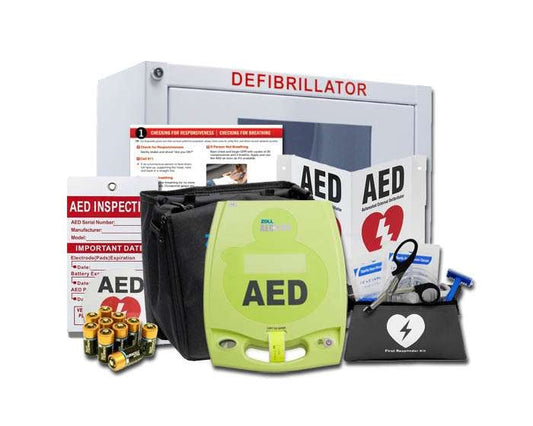
ZOLL AED Plus Value Package
<h2><strong>Enhance Life-Saving Readiness with the Response Ready ZOLL AED Plus Package</strong></h2> <p><em>Complete Package:</em></p> <ul> <li>New ZOLL AED Plus</li> <li>Carry Case</li> <li>7-Year Warranty</li> <li>User Manual</li> <li>Pads & Battery (Pre-Installed)</li> <li>AED Wall Cabinet</li> <li>First Responder Kit*</li> <li>AED 3-Way Sign</li> <li>AED Wall Poster</li> <li>AED Inspection Card (I-Tag)</li> <li>“AED On-Site” Window Decal (AEDecal)</li> <li>Free Shipping</li> </ul> <p>*First Responder Kit includes towelettes, scissors, razors, nitrile gloves, and a pocket CPR mask in a zippered nylon pouch.</p> <h3>Customizable Options for Your Needs:</h3> <ol> <li> <em>AED Variants:</em> <ul> <li>Available in both semi-automatic and automatic versions.</li> <li>Semi-automatic version prompts the user to press a “Shock” button.</li> <li>Fully automatic version (additional cost) delivers shock automatically.</li> </ul> </li> <li> <em>Cabinet Upgrade:</em> <ul> <li>Upgrade the standard cabinet for enhanced security.</li> <li>Options include cabinets with alarms and/or strobe lights.</li> </ul> </li> <li> <em>Optional Add-Ons:</em> <ul> <li>Bleeding control kit available to prevent traumatic blood loss.</li> </ul> </li> </ol> <h3>Order from Response Ready:</h3> <ul> <li>Authorized ZOLL distributor, ensuring authenticity.</li> <li>Customizable packages to meet specific requirements.</li> </ul> <p><em>Explore our range of <a href="/product-category/value-packages/">AED packages</a> for other defibrillator models.</em></p> <h3>ZOLL AED Plus Device Highlights:</h3> <ol> <li> <em>Audible and Visual Coaching:</em> <ul> <li>Calm, clear voice coaching for ease of use by lay responders.</li> <li>Large rescue graphics for visual context in noisy environments.</li> </ul> </li> <li> <em>Intuitive CPR Feedback:</em> <ul> <li>Real-time instruction and feedback during CPR.</li> <li>CPR Bar Gauge for compression depth and rate guidance.</li> </ul> </li> <li> <em>One-Piece Electrode Pads:</em> <ul> <li> <a href="/product/zoll-cpr-d-padz/">ZOLL CPR-D-padz</a> for easy application.</li> <li>Simplified placement with a single frame design.</li> </ul> </li> <li> <em>Rugged Design:</em> <ul> <li>IP55 rating for dust and water protection.</li> <li>Meets military standards for shock and vibration resistance.</li> <li>Suitable for use in boats and aircraft.</li> </ul> </li> </ol> <p><em>Order your ZOLL AED Plus Package from Response Ready for unparalleled life-saving capabilities.</em></p> <div style="float: left; width: 49%;"> <h4>ZOLL AED Plus Overview</h4> <p><iframe src="https://www.youtube.com/embed/KjvcBU35j9k" width="560" height="315" frameborder="0" allowfullscreen="allowfullscreen"></iframe></p> <p> </p> </div> <div style="float: right; width: 49%;"> <h4>ZOLL AED Plus Training Video</h4> <p><iframe src="https://www.youtube.com/embed/EHX-RiJ8EbM" width="560" height="315" frameborder="0" allowfullscreen="allowfullscreen"></iframe></p> </div>
ZOLL AED Plus Value Package
view productRegular price $2,142.50Regular priceUnit price / per$250 OFF - Code: ZPLUS250
-

Physio-Control LIFEPAK CR2 Value Package
<div class="tab-contents"> <div align="justify"> <h2><strong>Elevate Your AED Program with the Response Ready LIFEPAK CR2 Value Package</strong></h2> <p>Unlock the potential of automated external defibrillation with the cutting-edge <a href="https://responseready.com/products/physio-control-lifepak-cr2">LIFEPAK CR2</a> from Stryker, available in both semi- and fully automatic editions. Response Ready presents the LIFEPAK CR2 Value Package, bundling the AED with essential accessories at an unbeatable price.</p> <p><strong>What’s Included:</strong></p> <ul> <li>New Physio-Control LIFEPAK CR2 AED</li> <li>Carry Case or Handle</li> <li>8-Year Warranty</li> <li>User Manual</li> <li>Pads & Battery (Pre-Installed)</li> <li>AED Wall Cabinet</li> <li>First Responder Kit*</li> <li>AED 3-Way Sign</li> <li>AED Wall Poster</li> <li>AED Inspection Card (I-Tag)</li> <li>“AED On-Site” Window Decal (AEDecal)</li> </ul> <p>*The First Responder Kit comprises first-aid essentials in a convenient zippered nylon pouch: two towelettes, scissors, a razor, a pair of nitrile gloves, and a pocket CPR mask.</p> <h2><strong>Effortless Operation for Lay Responders</strong></h2> <p>The LIFEPAK CR2 is designed for ease of use, especially for those with minimal training:</p> <ul> <li>Audible coaching guides users through CPR and defibrillation.</li> <li>The metronome aids in performing CPR with professional precision.</li> <li>ClearVoice™ Technology ensures audible coaching in various environments, adjusting volume based on ambient noise.</li> </ul> <p><strong>Semi- and Fully Automatic Models</strong></p> <p>Choose the model that suits your needs:</p> <ul> <li>Semi-automatic model with a “Shock” button for manual intervention.</li> <li>Fully automatic model for hands-free defibrillation, eliminating user anxiety.</li> </ul> <p><strong>Rugged and Versatile Design</strong></p> <p>The LIFEPAK CR2 excels in durability and versatility:</p> <ul> <li>Compact and lightweight with an IP55 rating for dust and water resistance.</li> <li>cprINSIGHT™ Analysis allows uninterrupted CPR during heart rhythm analysis.</li> <li>Child and optional bilingual modes enhance usability.</li> </ul> <h2><strong>Why Choose Response Ready?</strong></h2> <p>As an authorized distributor of Stryker and <a href="https://responseready.com/collections/physio-control">Physio-Control AEDs</a>, Response Ready offers:</p> <ul> <li>Free shipping for the LIFEPAK CR2 Value Package.</li> <li>30-day return policy for added peace of mind.</li> <li>One-year low-price guarantee, ensuring the best value.</li> </ul> <p><strong>Order Your Physio-Control LIFEPAK CR2 Value Package Today</strong></p> <p>Invest in the future of AED programs with Response Ready. Order the LIFEPAK CR2 Value Package and equip your facility with state-of-the-art lifesaving technology.</p> </div> </div>
Physio-Control LIFEPAK CR2 Value Package
view productRegular price From $2,376.90Regular priceUnit price / per$400 OFF - Code: CR2400
-

Cardiac Science Powerheart AED G3 Pro Value Package
<h2><strong>Discover the Powerheart® G5 AED Value Package – Your Trusted Lifesaving Companion</strong></h2> <p><em>Currently Unavailable - Consider the Powerheart® G5 AED Value Package as an Excellent Alternative</em></p> <p><em>Package Contents:</em></p> <ul> <li>New Cardiac Science Powerheart AED G3 Pro</li> <li>Carry Case</li> <li>7-Year Warranty</li> <li>User Manual</li> <li>Pads & Battery (Pre-Installed)</li> <li>AED Wall Cabinet</li> <li>First Responder Kit*</li> <li>AED 3-Way Sign</li> <li>AED Wall Poster</li> <li>AED Inspection Card (I-Tag)</li> <li>“AED On-Site” Window Decal (AEDecal)</li> <li>Club AED (Pad and Battery Expiration Reminders)</li> <li>Free Shipping</li> </ul> <p><em>The First Responder Kit's zippered nylon pouch includes essential first-aid items for cardiac emergencies: pocket CPR mask, nitrile gloves, scissors, razor, and two towelettes.</em></p> <p><strong>Key Advantages of the Powerheart G3 Pro:</strong></p> <ul> <li> <strong>Complete Control:</strong> <ul> <li>Semi-automatic operation with a manual override option.</li> <li>3-lead ECG monitoring capability.</li> </ul> </li> <li> <strong>Reliability:</strong> <ul> <li>Rescue Ready® technology with daily self-tests for assured functionality.</li> </ul> </li> <li> <strong>User-Friendly Features:</strong> <ul> <li>Industry-first color ECG display for vital patient information.</li> <li>Built-in metronome sets CPR compression pace.</li> <li>AED mode intelligently determines shock delivery.</li> </ul> </li> <li> <strong>Assurance:</strong> <ul> <li>7-year warranty for long-term peace of mind.</li> </ul> </li> </ul> <p><strong>Rescue Ready® Performance – Setting the Standard:</strong></p> <ul> <li> <strong>Daily Self-Checks:</strong> <ul> <li>Ensures functionality by testing battery, hardware, software, and pads.</li> </ul> </li> <li> <strong>Weekly Partial Charge:</strong> <ul> <li>Charges high-voltage electronics for sustained readiness.</li> </ul> </li> <li> <strong>Monthly Full Energy Charge:</strong> <ul> <li>Ensures high-voltage electronics are fully charged.</li> </ul> </li> </ul> <p><strong>What Sets Powerheart AEDs Apart:</strong></p> <ul> <li>Green indicator signals Rescue Ready status.</li> <li>Red indicator with audible alert prompts servicing if issues arise.</li> </ul> <p><em>In critical situations, a Powerheart AED guarantees Rescue Ready reliability, ensuring your peace of mind when it matters most.</em></p> <p><strong>Experience the Unmatched <a href="/product/cardiac-science-powerheart-g5-aed-value-package/">Confidence of the Powerheart G3 Pro</a>. Order Yours Today!</strong></p> <p> </p> <h4 class="title style-scope ytd-video-primary-info-renderer">Overview and Demonstration of the Cardiac Science G3 AED</h4> <p><iframe src="https://www.youtube.com/embed/E5p5UqULVsA" width="560" height="315"></iframe></p> <p> </p> <p>You may want to take a look at our <a href="https://responseready.com/collections/cardiac-science-value-packages">Cardiac Science AED Packages page</a>, which features packages containing other models by Cardiac Science.</p>
Cardiac Science Powerheart AED G3 Pro Value Package
view productRegular price $2,589.00Regular priceUnit price / per -

Cardiac Science Powerheart® G5 AED Value Package
<h2><strong>Experience Lifesaving Excellence with the Powerheart® G5 AED - Your Trusted Partner in Cardiac Emergencies</strong></h2> <p><em>Unleash the Power of the G5 AED Value Package - What's Inside:</em></p> <ul> <li>New Cardiac Science Powerheart® G5 AED</li> <li>Carry Case</li> <li>8-Year Warranty</li> <li>User Manual</li> <li>Pads & Battery (Pre-Installed)</li> <li>AED Wall Cabinet</li> <li>First Responder Kit*</li> <li>AED 3-Way Sign</li> <li>AED Wall Poster</li> <li>AED Inspection Card (I-Tag)</li> <li>“AED On-Site” Window Decal (AEDecal)</li> <li>Free Shipping</li> </ul> <p><em>The First Responder Kit contains essential first-aid tools: two towelettes, scissors, a razor, a pair of nitrile gloves, and a pocket CPR mask, all neatly organized in a convenient zippered nylon pouch.</em></p> <h3>Powerful Features for Every Rescuer:</h3> <ul> <li> <strong>User-Friendly Design:</strong> <ul> <li>User-paced RescueCoach™ voice and text prompts guide rescuers step by step.</li> <li>Pads can be placed on either side of the victim's chest for flexibility.</li> </ul> </li> <li> <strong>Full Automatic Shock Delivery:</strong> <ul> <li>Unprecedented combination of automatic shock delivery and dual-language functionality.</li> <li>Variable escalating energy ensures effective therapy.</li> </ul> </li> <li> <strong>Swift and Smart Operation:</strong> <ul> <li>Fast shock times of 10 seconds or less when needed.</li> <li>Incredibly smart defibrillation energy escalation for optimal patient care.</li> </ul> </li> </ul> <h3>Reliability Beyond Measure:</h3> <ul> <li> <strong>Rescue Ready® Assurance:</strong> <ul> <li>Highly visible indicator confirms daily, weekly, and monthly self-tests passed.</li> <li>Over 4,100 hours of global daily self-tests, ensuring readiness.</li> </ul> </li> <li> <strong>Rugged and Durable:</strong> <ul> <li>Tested to military standards for durability.</li> <li>IP55 rating for protection against dust and water.</li> </ul> </li> </ul> <h3>Fluency in Lifesaving:</h3> <ul> <li> <strong>Dual-Language Functionality:</strong> <ul> <li>Easily switch voice prompts between languages without restarting or delaying rescue.</li> </ul> </li> </ul> <p><em>Whether you're a seasoned rescuer or a first-time responder, the Powerheart G5 AED empowers you with the tools needed for effective, swift, and life-saving therapy in sudden cardiac arrest situations. Order your Response Ready G5 AED today and be prepared for the unexpected.</em></p> <p> </p> <h4>An Overview and Demonstration of the Cardiac Science G5 AED</h4> <p><iframe src="https://www.youtube.com/embed/_3BDY1pS2ao" width="560" height="315" frameborder="0" allowfullscreen="allowfullscreen"></iframe></p> <p> </p> <p>Check out our Cardiac Science AED Packages page if you are interested in a package that includes a different <a href="https://responseready.com/collections/cardiac-science-aed-defibrillators">Cardiac Science AED model</a>.</p>
Cardiac Science Powerheart® G5 AED Value Package
view productRegular price From $2,217.50Regular priceUnit price / per -

Philips HeartStart FRx Value Package
<h2><strong>Unlock Lifesaving Potential with the Philips HeartStart FRx AED Value Package</strong></h2> <p><em>Experience the Comprehensive FRx AED Value Package:</em></p> <ul> <li>New Philips HeartStart FRx AED</li> <li>Carry Case</li> <li>8-Year Warranty</li> <li>User Manual</li> <li>Pads & Battery (Pre-Installed)</li> <li>AED Wall Cabinet</li> <li>First Responder Kit*</li> <li>AED 3-Way Sign</li> <li>AED Wall Poster</li> <li>AED Inspection Card (I-Tag)</li> <li>“AED On-Site” Window Decal (AEDecal)</li> <li>Free Shipping</li> </ul> <p><em>The First Responder Kit contains essential items for cardiac emergencies: one pair of nitrile gloves, a pocket CPR mask, scissors, a razor, and two towelettes, neatly organized in a convenient nylon pouch.</em></p> <h2>Revolutionary Features for Swift Response:</h2> <ul> <li> <strong>CPR Assistance with Life Guidance:</strong> <ul> <li>Press the blue i-button for CPR assistance.</li> <li>Life Guidance provides step-by-step instructions and audio cues for chest compressions and breaths.</li> </ul> </li> <li> <strong>Defibrillation Guidance Made Easy:</strong> <ul> <li>Place pads on bare skin following the placement diagram.</li> <li>Press the orange Shock button when prompted.</li> <li>Visual icons and a quick reference guide enhance voice instructions for clarity in noisy environments.</li> </ul> </li> <li> <strong>EMS Hand-Off Reminder:</strong> <ul> <li>Receive reminders to ensure EMS has been called.</li> <li>Seamless hand-off to EMS with compatibility for advanced defibrillators from Philips and other manufacturers.</li> </ul> </li> </ul> <p><em>The FRx AED from Response Ready is your trusted partner in critical situations. Order now for a reliable, user-friendly, and efficient AED solution that stands ready to save lives.</em></p> <h2><br></h2> <div id="demovideo"><iframe height="315" width="560" src="https://www.youtube.com/embed/FvUhnSgGMRw?rel=0"></iframe></div> <div><br></div> <div> <p>If you're looking for a package with a different Philips model, take a look at our page for <a href="https://responseready.com/collections/philips">Philips AED Packages</a>. We also have high-quality <a href="/product/philips-heartstart-frx-aed-recertified/">refurbished FRx devices</a> available for purchase.</p> </div>
Philips HeartStart FRx Value Package
view productRegular price From $2,060.00Regular priceUnit price / per$200 OFF - Code: FRX200
-

Heartsine Samaritan PAD 360P AED Package
<div class="tab-contents"> <h2><strong>Unleash your Lifesaving Potential with the HeartSine Samaritan PAD 360P AED Complete Bundle</strong></h2> <p><em>Explore the Power of Preparedness with:</em></p> <ul> <li>New HeartSine Samaritan PAD 360P AED</li> <li>Carry Case</li> <li>8-Year Warranty</li> <li>User Manual</li> <li>Pads & Battery (Pre-Installed)</li> <li>AED Wall Cabinet</li> <li>First Responder Kit*</li> <li>AED 3-Way Sign</li> <li>AED Wall Poster</li> <li>AED Inspection Card (I-Tag)</li> <li>“AED On-Site” Window Decal (AEDecal)</li> <li>Free Shipping</li> </ul> <p><em>The First Responder Kit embraces crucial first-aid tools: two towelettes, scissors, a razor, a pair of nitrile gloves, and a pocket CPR mask, neatly arranged in a zippered nylon pouch.</em></p> <h3>Elevate Your Response with the HeartSine Samaritan PAD 360P AED:</h3> <ul> <li> <strong>Designed for Lay Responders:</strong> <ul> <li>Lightweight and user-friendly, ideal for workplaces, schools, or manufacturing settings.</li> <li>Complements AED programs seamlessly.</li> </ul> </li> <li> <strong>Compact and Durable:</strong> <ul> <li>The smallest and lightest AED in its class, weighing only 2.4 lbs.</li> <li>Boasts the highest durability ratings, including an IP56 Dust & Water Rating and Military Standard Drop Test.</li> </ul> </li> <li> <strong>Authorized Distributor:</strong> <ul> <li>Proudly delivered by Response Ready, your trusted source for HeartSine AED Defibrillators.</li> </ul> </li> </ul> <p><strong>Learn and Train with HeartSine AED - Samaritan PAD Instructional Video</strong></p> <p>Explore Additional <a href="https://responseready.com/collections/heartsine-value-packages">HeartSine AED Packages</a> for diverse models and tailored options. Choose Response Ready for unparalleled AED solutions.</p> </div>
Heartsine Samaritan PAD 360P AED Package
view productRegular price $1,701.60Regular priceUnit price / per$200 OFF - Code: HEARTSINE200
FIRST AID KITS
-
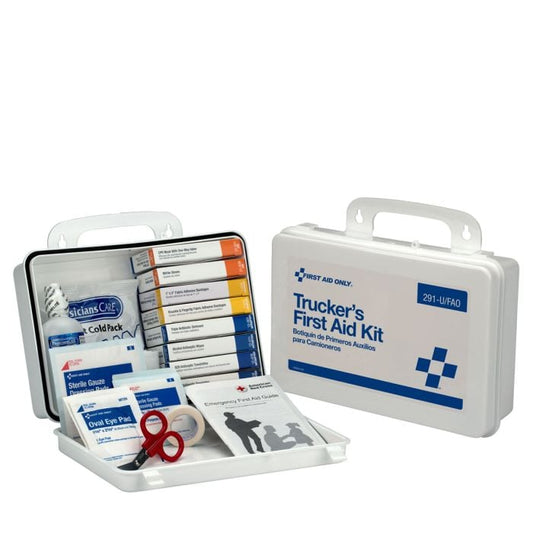
Waterproof 16 Unit ANSI A First Aid Kit
<h3><span data-sheets-root="1"><strong>Metal, Weatherproof, 16 Units</strong></span></h3> <p><span> </span><span data-sheets-root="1">Waterproof case comes with a carrying handle and is wall mountable. Unitized contents meet the 2025 ANSI Class A requirements and are sufficient to treat 25 or more people.</span><span> </span><strong>SIZE 9.25″ x 7.75″ x 4.25″ ANSI 2015 Compliant</strong><span> </span><strong>Contents:</strong><span> Fabric Bandages, 1″ x 3″, 16ct, 1 First Aid Tape, 1 CPR Mask, 1 Scissors, Triple Antibiotic Ointment Packets, 12ct, BZK Antiseptic Towelettes, 10ct, Burn Dressing, 4″ x 4″ , First Aid/Burn Cream Packets, 0.9g, 12ct, Cold Compress, 4″ x 5″ , 1 Eyewash, 1oz, with 2 Eye Pads and 2 Strips, Hand Sanitizer Packets, 0.9g, 10ct, Nitrile Exam Gloves, 4ct, Conforming Gauze Roll, 2″, 2ct, Gauze Dressing Pads, 3″ x 3″, 4ct, Trauma Pads, 5″ x 9″, 1/box, Triangular Sling/Bandage, 40″ x 40″ x 56″ , First Aid Guide </span></p>
Waterproof 16 Unit ANSI A First Aid Kit
view productRegular price $88.62Regular priceUnit price / per -
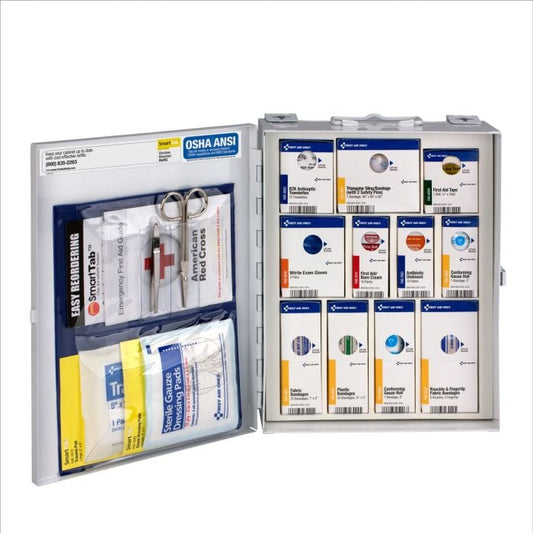
Medium Metal SmartCompliance First Aid Cabinet
<h3>Without Medications</h3> <p>Compact, solid steel case comes with a carrying handle and is wall mountable.<br>Contents exceed the 2015 ANSI Class A requirements and are sufficient to treat 25 or more people.</p> <p><strong>SIZE 9.5″ x 12″ x 3″ ANSI 2015 Compliant</strong></p> <p><strong>Contents:</strong> 1 Triangular Bandage & 1CPR Mask, First Aid Guide, Adhesive Fabric Bandages, 1″ x 3″, 25ct, BZK Antiseptic Towelettes, 10ct, Hand Sanitizer Packets, 10ct, Sterile Gauze<br>Pads, 3″ x 3″, 10ct, Trauma Pads, 5″ x 9″, 2ct, First Aid Tape, 1⁄2″ x 5yd and Gauze Roll, 2″ x 4yd, Cold Pack, 4″ x 5″ , Nitrile Exam Gloves, 4ct, ) 2 Sterile Eyepads, 1 oz Eyewash, 1⁄2″ x 5<br>yd Tape Roll, Burn Cream Packets, 10ct, Burn Dressing, 4″ x 4″ , Antibiotic Ointment Packets, 10ct, Tweezers, Scissors</p>
Medium Metal SmartCompliance First Aid Cabinet
view productRegular price $171.31Regular priceUnit price / per -
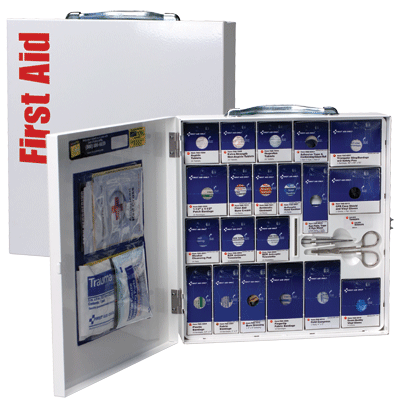
Large Metal SmartCompliance First Aid Cabinet
<h3>Without Medications</h3> <p>Solid steel case comes with a carrying handle and is wall mountable.<br>Contents exceed the 2015 ANSI Class A requirements and are sufficient to treat 50 or more people.</p> <p><strong>SIZE 13.5″ x 14.5″ x 3″ ANSI 2015 Compliant</strong></p> <p><strong>Contents:</strong> Patch Plastic Bandages, 11⁄2″ x 11⁄2″, 10ct, Adhesive Fabric Bandages, 1″ x 3″, 25ct, Adhesive Plastic Bandages, 3⁄4″ x 3″, 25ct, Fingertip Fabric Bandages, 10ct, Elastic<br>Bandage Wrap, 2″ x 5 yd, Alcohol Wipes, 20ct, BZK Antiseptic Towelettes, 10ct, Castile Soap Wipes, 10ct, Hand Sanitizer Packets, 10ct, Sterile Gauze Pads, 2″ x 2″, 10ct, Sterile<br>Gauze Pads, 3″ x 3″, 10ct, Trauma Pads, 5″ x 9″, 2ct, First Aid Tape, 1⁄2″ x 5yd and Gauze Roll, 2″ x 4yd, Triangular Bandage, 40″ x 40″ x 56″ , Cold Pack, 4″ x 5″ , Moleskin Blister<br>Prevention, 2″ x 2″, 10ct, 1 CPR Mask and 2 Nitrile Exam Gloves, Nitrile Exam Gloves, 4ct, 2 Sterile Eyepads, 1oz Eyewash, 1⁄2″ x 5 yd Tape Roll, Burn Cream Packets, 10ct, Burn<br>Dressing, 4″ x 4″ , Antibiotic Ointment Packets, 10ct, Forceps, Scissors</p>
Large Metal SmartCompliance First Aid Cabinet
view productRegular price $255.98Regular priceUnit price / per -
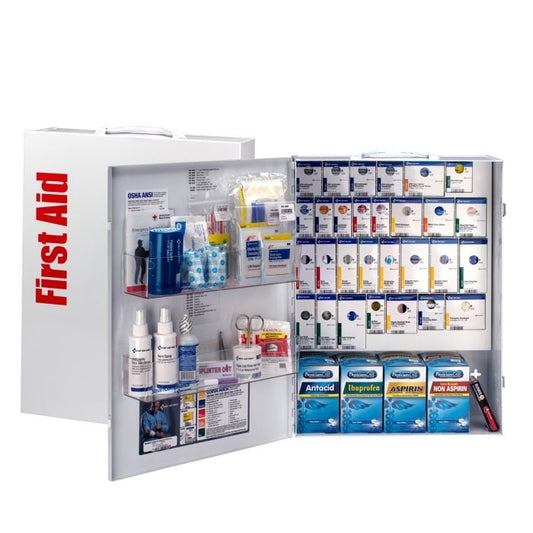
XXL Metal SmartCompliance First Aid Cabinet
<h3>General Business without Medications</h3> <p>Solid steel case comes with a carrying handle and is wall mountable.<br>Contents exceed the 2015 ANSI Class B requirements and are sufficient to treat 200 or more people.</p> <p><strong>SIZE 17″ x 26″ x 5.75″ ANSI 2015 Compliant</strong></p> <p><strong>Contents:</strong> Thera Tears .02oz Packs, 16ct, Conforming Gauze Roll, 2″ x 5yd, 2ct, 4oz Burn Spray, 4oz Antiseptic Spray, Patch Bandages 1.5″ x 1.5″, 10ct, Adhesive Plastic Bandages, 1″</p> <p>x 3″, 40ct, Adhesive Fabric Bandage, 1″ x 3″, 40ct, Gauze Roll, 4″ , Junior Bandages, 40 ct, Spot Bandages, 30ct, Alcohol Wipes, 20ct, BZK towelettes, 10ct, Iodine Wipes, 10ct, Hand</p> <p>Sanitizer, 10ct, ) Lip Balm Packets, 10ct, Castile Soap, 10ct, Gauze Pads, 2″ x 2″, 10ct, Gauze Pads, 3″ x 3″, 10ct, Hema Flex Bandages, 2″, 4ct, Triangular Bandages, 2ct, Scissors,</p> <p>Cold Compress, 4″ x 5″ , Tweezers, 2 Sterile Eyepads, 1oz Eyewash, 1⁄2″ x 5yd Tape Roll, Trauma Pads, 5″ x 9″, 2ct, Moleskin Bandages, 20ct, 1 CPR Mask & 4 Gloves, Fabric Fingertip</p> <p>Bandages, 20ct, Nitrile Exam Gloves, 8ct, First Aid Tape, 1⁄2″ x 5yd, 2ct, Elastic Bandages, 2″ , 6 Bandages, 2″ x 4″ & 10 Butterfly Bandages, Fabric Knuckle Bandages, 20ct, Burn</p> <p>Dressing, 4″ x 4″ , 4oz Eyewash, Tourniquet, Ammonia Inhalants, 10ct, First Aid/Burn Cream, 20ct, Antibiotic Ointment, 20ct, 20 Sting Relief Wipes & 10 Hydrocortisone Packets,</p> <p>Triple Cut Adhesive Tape, 2″ , WoundSeal Packs, 2ct, Liquid Skin, Padded Flexible Splint, 4″ x 24″ , Red Cross First Aid Guide, Hema-Seal Trauma Dressing, 1 Eye & Face Shield & 2</p> <p>Nitrile Exam Gloves, Body Fluid Spill Clean-Up Pack, Splinter Out 10/Bx, Cotton Tipped Applicators, 100ct, Wound Dressing Pack # 10, Non Stick Pads, 3″ x 4″, 50ct</p>
Sold outXXL Metal SmartCompliance First Aid Cabinet
view productRegular price $468.94Regular priceUnit price / per -
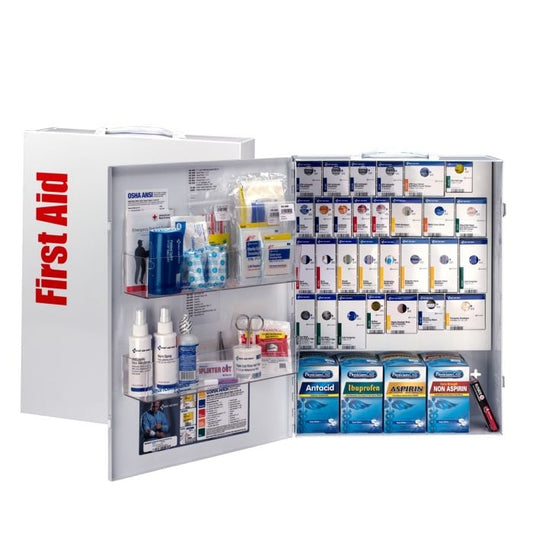
XL Metal SmartCompliance First Aid Cabinet
<h3>Food Service without Medications</h3> <p>Solid steel case comes with a carrying handle and is wall mountable.<br>Contents exceed the 2015 ANSI Class B requirements and are sufficient to treat 150 or more people.</p> <p><strong>SIZE 17″ x 22.5″ x 5.75″ ANSI 2015 Compliant</strong></p> <p><strong>Contents:</strong> Thera Tears .02oz Packs, 16ct, Conforming Gauze Roll, 2″ x 5yd, 2ct, 4oz Burn Spray, 4oz Antiseptic Spray, Blue Metal Detectable Fabric Bandages, 1″ x 3″, 40ct, Blue Metal<br>Detectable Knuckle Bandages, 20ct, Blue Metal Detectable Fingertip Bandages, 20ct, Gauze Roll, 4″ , Blue Metal Detectable Foam Bandages, 1″ x 3″, 25ct, Alcohol Wipes, 20ct, BZK<br>towelettes, 10ct, Hand Sanitizer, 10ct, Gauze Pads, 2″ x 2″, 10ct, Gauze Pads, 3″ x 3″, 10ct, Triangular Bandages, 2ct, 3″ Self Adhering Wrap Blue, Scissors, Cold Compress, 4″ x 5″ ,<br>Tweezers, 2 Sterile Eyepads, 1oz Eyewash, 1⁄2″ x 5yd Tape Roll, Trauma Pads, 5″ x 9″, 2ct, 1 CPR Mask & 4 Gloves, Nitrile Exam Gloves, 8ct, ) First Aid Tape, 1⁄2″ x 5yd, 2ct, Elastic<br>Bandages, 2″ , 6 Bandages, 2″ x 4″ & 10 Butterfly Bandages, Finger Cots, 50ct, Burn Dressing, 4″ x 4″ , 4oz Eyewash, Tourniquet, First Aid/Burn Cream, 20ct, Antibiotic Ointment, 20ct,<br>20 Sting Relief Wipes & 10 Hydrocortisone Packets, Triple Cut Adhesive Tape, 2″ , WoundSeal Packs, 2ct, Liquid Skin, Padded Flexible Splint, 4″ x 24″ , Red Cross First Aid Guide,<br>Hema-Seal Trauma Dressing, 1 Eye & Face Shield & 2 Nitrile Exam Gloves, Body Fluid Spill Clean-Up Pack, Splinter Out 10/Bx, Cotton Tipped Applicators, 100ct, Ammonia<br>Inhalants, 10ct, PVP Iodine Wipes, 50ct, Burn Gel 1/8oz, 25ct, Non Stick Pads, 3″ x 4″, 50ct, Cold Pack, 4″ x 5″</p>
XL Metal SmartCompliance First Aid Cabinet
view productRegular price $594.80Regular priceUnit price / per -
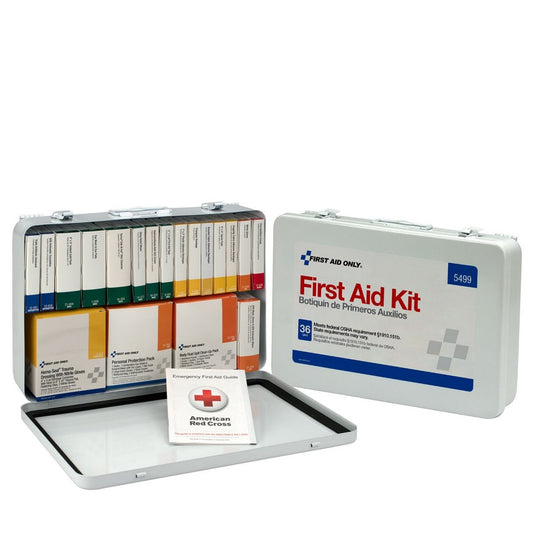
36 Unit ANSI A+ First Aid Kit
<h3>Metal, Weatherproof w/ BBP Pack, 36 Units<br> </h3> <p><br>Weatherproof case comes with a carrying handle and is wall mountable.<br>Unitized contents exceed the 2025 ANSI Class A requirements and are sufficient to treat 75 or more people.</p> <p><strong>SIZE 14″ x 10″ x 2.75″ ANSI 2015 Compliant</strong></p> <p><strong>Contents:</strong> Fabric Bandages, 1″ x 3″, 16ct, 1 First Aid Tape, 1 CPR Mask, 1 Scissors, Triple Antibiotic Ointment Packets, 12ct, BZK Antiseptic Towelettes, 10ct, Burn Dressing, 4″ x 4″ ,<br>First Aid/Burn Cream Packets, 0.9g, 12ct, Cold Compress, 4″ x 5″ , 1 Eyewash, 1oz, with 2 Eye Pads and 2 Strips, Hand Sanitizer Packets, 0.9g, 10ct, Nitrile Exam Gloves, 4ct,<br>Conforming Gauze Roll, 2″, 2ct, Gauze Dressing Pads, 3″ x 3″, 4ct, Trauma Pads, 5″ x 9″, 1/box, Triangular Sling/Bandage, 40″ x 40″ x 56″ , First Aid Guide, Knuckle & Fingertip Fabric<br>Adhesive Bandages, 9ct, Hydrocortisone Anti-Itch Cream Packets, 12ct, Sting Relief Wipes, 10ct, Hema-seal 4″ Major wound compress, Body Fluid Spill Clean-Up Pack (20 pcs),<br>BBP Personal Protection Pack (7 pcs)</p>
36 Unit ANSI A+ First Aid Kit
view productRegular price $231.43Regular priceUnit price / per -
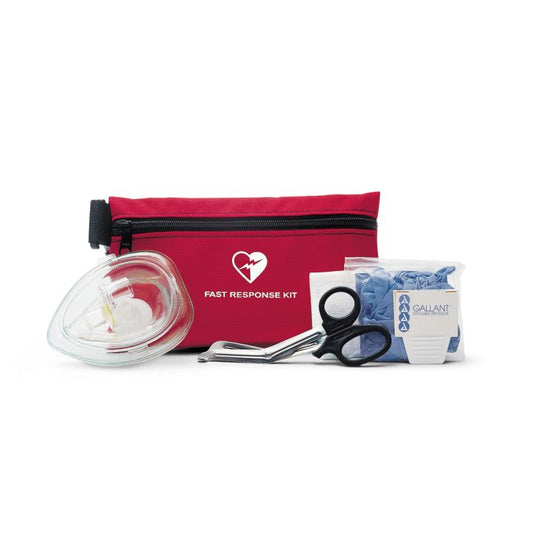
Philips Fast Response Kit
<h2><strong>Response Ready: Essential CPR/AED Response Kit</strong></h2> <p>Prepare for life-saving emergencies with the Response Ready CPR/AED Ready Kit. This comprehensive kit ensures you have the necessary tools for effective CPR and AED deployment in a compact, easy-to-carry case. Ideal for both trained responders and individuals ready to act in critical situations.</p> <p><strong>Key Features:</strong></p> <ul> <li> <strong>CPR Mask:</strong> High-quality CPR mask included for secure and sanitary resuscitation efforts.</li> <li> <strong>Nitrile Gloves:</strong> Two pairs of nitrile gloves for hand protection during emergency response.</li> <li> <strong>Antimicrobial Wipe:</strong> An antimicrobial wipe for maintaining cleanliness and minimizing infection risk.</li> <li> <strong>Scissors:</strong> Reliable scissors for quick and precise cutting when needed.</li> <li> <strong>Disposable Razor:</strong> One disposable razor for efficient hair removal in preparation for electrode pad placement.</li> <li> <strong>Red Zippered Soft Case:</strong> All components are neatly organized in a vibrant red zippered case for easy identification and access.</li> </ul> <p><strong>Benefits:</strong></p> <ul> <li> <strong>Compact and Portable:</strong> Designed for on-the-go readiness, fitting easily in bags, backpacks, or glove compartments.</li> <li> <strong>Versatile Use:</strong> Suitable for various environments, including homes, workplaces, and public spaces.</li> <li> <strong>Peace of Mind:</strong> Ensure you are well-equipped to respond promptly to cardiac emergencies.</li> </ul> <p><strong>Response Ready: Your Partner in Emergency Preparedness</strong></p> <p>Empower yourself with the Response Ready CPR/AED Ready Kit, a compact and reliable solution for effective emergency response. Order now and be prepared to make a difference in critical moments.</p> <p><em>Explore bulk pricing options for large-quantity orders. Contact us for wholesale inquiries.</em></p>
Philips Fast Response Kit
view productRegular price $57.00Regular priceUnit price / per -
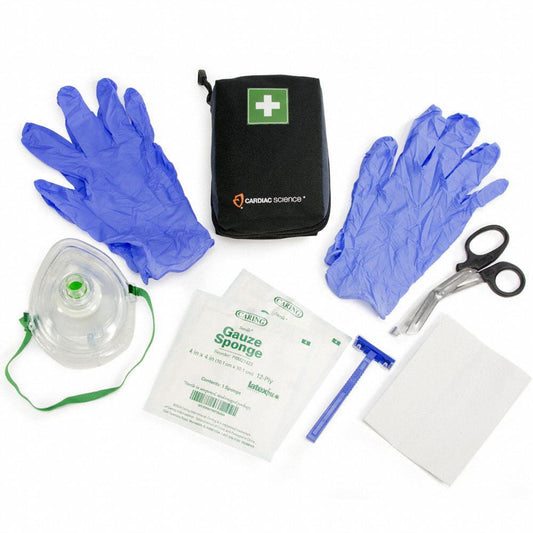
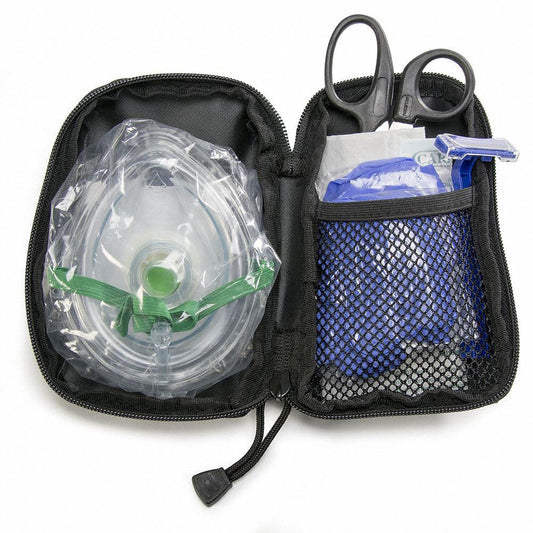
Cardiac Science Powerheart G5 AED Ready Kit
<h2><strong>Elevate Your Preparedness with the Powerheart G5 AED Ready Kit from Response Ready</strong></h2> <p>Equip yourself for life-saving moments with the <a href="/product/cardiac-science-powerheart-g5-aed/">Powerheart G5 AED</a> Ready Kit, a comprehensive set designed for immediate response in emergencies. Explore the features that make this kit an essential addition to your safety arsenal, available at Response Ready.</p> <p><strong>Key Components:</strong></p> <ul> <li>CPR mask</li> <li>Nitrile gloves</li> <li>Scissors</li> <li>Disposable razor</li> <li>Paper towels (2)</li> <li>Gauze</li> <li>All neatly organized in a rugged pouch for easy accessibility.</li> </ul> <p><strong>Enhance Your Emergency Response with the Powerheart G5 AED Ready Kit:</strong></p> <ul> <li> <strong>Comprehensive Protection:</strong> <ul> <li>Includes essential items for immediate first aid response.</li> <li>CPR mask and nitrile gloves provide a protective barrier during resuscitation efforts.</li> </ul> </li> <li> <strong>Convenient Accessibility:</strong> <ul> <li>Neatly organized in a rugged pouch for quick and easy access.</li> <li>Ideal for placement alongside your Powerheart G5 AED for seamless response.</li> </ul> </li> <li> <strong>User-Friendly Design:</strong> <ul> <li>Scissors and disposable razor facilitate efficient removal of clothing for emergency care.</li> <li>Paper towels and gauze for effective wound management.</li> </ul> </li> </ul> <p><strong>Why Choose the Powerheart G5 AED Ready Kit from Response Ready:</strong></p> <ul> <li> <strong>Trusted Source:</strong> Response Ready is your authorized distributor for the Powerheart G5 AED Ready Kit.</li> <li> <strong>Immediate Accessibility:</strong> The rugged pouch ensures that essential items are readily available when needed.</li> <li> <strong>Comprehensive Preparedness:</strong> A perfect complement to your Powerheart G5 AED for a well-rounded emergency response.</li> </ul> <p><strong>Order Your Powerheart G5 AED Ready Kit Today and Be Response Ready.</strong></p> <p>Explore our range of emergency response solutions at Response Ready. Elevate your preparedness with the Powerheart G5 AED Ready Kit—a compact and essential addition to your safety toolkit.</p>
Cardiac Science Powerheart G5 AED Ready Kit
view productRegular price $77.00Regular priceUnit price / per -
First Responder Kit - Red
view productRegular price $20.40Regular priceUnit price / per -
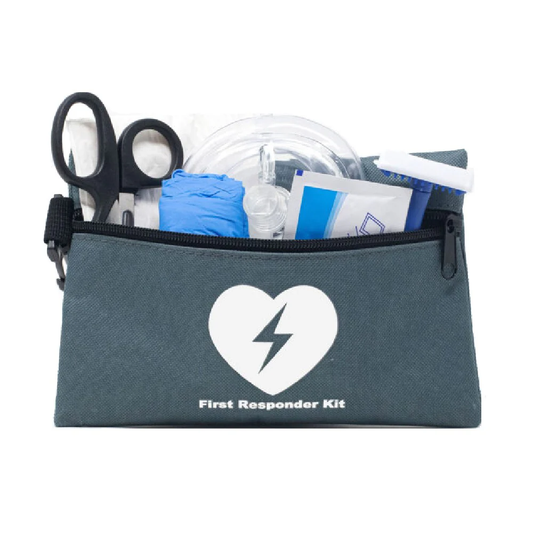
First Responder Kit - Gray
<p><strong>Elevate Your First Aid Readiness with the Response Ready First Responder Kit</strong></p> <p><strong>Contents:</strong></p> <ul> <li> <strong>Nylon Zippered Pouch:</strong> Compact and durable for easy storage and quick access.</li> <li> <strong>Nitrile Gloves (1 Pair):</strong> Provides protection and maintains a hygienic response environment.</li> <li> <strong>Pocket CPR Mask:</strong> Essential for administering CPR safely and effectively.</li> <li> <strong>Scissors (1 Pair):</strong> Versatile and sharp, suitable for various first aid situations.</li> <li> <strong>Razor:</strong> For quick and precise cutting in emergency scenarios.</li> <li> <strong>Towelettes (2):</strong> Conveniently packed for sanitation and cleaning.</li> </ul>
First Responder Kit - Gray
view productRegular price $20.40Regular priceUnit price / per
AED BATTERIES
-
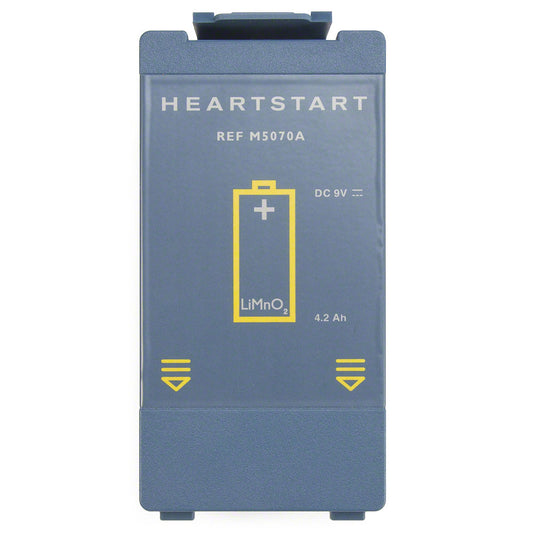
Philips HeartStart Battery M5070A
<h2><strong>Response Ready: Philips HeartStart M5070A AED Battery</strong></h2> <p>Upgrade your AED's power source with the Philips HeartStart M5070A AED Battery. Designed for optimal performance and reliability, this battery ensures your AED is ready to respond when every second counts.</p> <p><strong>Key Specifications:</strong></p> <ul> <li> <strong>Operating Time:</strong> Provides 4 hours of continuous operation or a minimum of 200 shocks.</li> <li> <strong>Shelf Life:</strong> The battery has a shelf life of five years, with a guaranteed four years of reliable use from the time of installation.</li> <li> <strong>Compatibility:</strong> Suitable for use with <a href="/product/philips-heartstart-frx-aed-861304/">Philips HeartStart FRx AED</a> and <a href="/product/philips-heartstart-onsite-aed-defibrillator-m5066a/">Philips HeartStart OnSite AED</a>.</li> </ul> <p><strong>Low-Battery Alert:</strong></p> <ul> <li>The AED emits an audio alert (chirp) and a visual alert (flashing i button) when the battery is low.</li> <li>Once the new battery is installed, the AED stops chirping, and the indicator light resumes blinking green.</li> </ul> <p><strong>Simple Replacement Process:</strong></p> <ol> <li>Remove the expired battery from the AED's back.</li> <li>Insert the new battery with arrows pointing down.</li> <li>The AED emits a beep and performs an audible self-test.</li> <li>Follow voice prompts to complete the self-test. The AED announces "Ready for use" when the process is complete.</li> </ol> <p><strong>Battery Management:</strong></p> <ul> <li>Easily track inspection and expiration dates by signing up for AED program management.</li> </ul> <p><strong>Order Your Philips HeartStart M5070A Battery:</strong> Stay prepared with Response Ready. Order the Philips HeartStart M5070A AED Battery today and benefit from our:</p> <ul> <li><strong>Complete Moneyback Guarantee</strong></li> <li><strong>Guaranteed Lowest Price for a Year</strong></li> <li><strong>Qualification for Free Shipping</strong></li> </ul> <p>Don't wait for expiration alerts; ensure your AED is always response-ready with the Philips HeartStart M5070A AED Battery from Response Ready.</p> <p><em>Explore bulk pricing options for large-quantity orders. Contact us for wholesale inquiries.</em></p>
Philips HeartStart Battery M5070A
view productRegular price $205.00Regular priceUnit price / per -

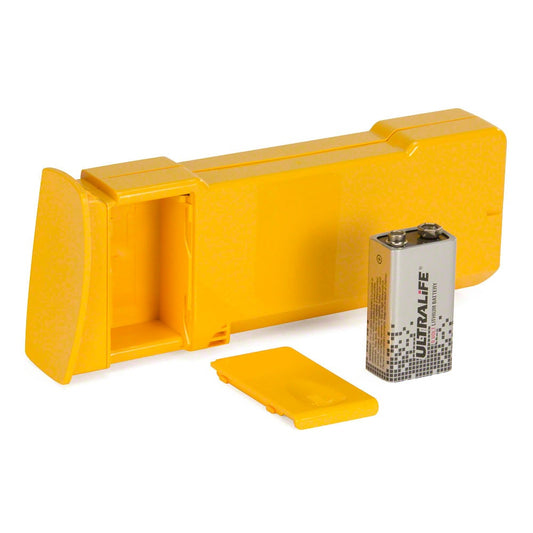
Defibtech Standard DBP-1400 Battery
<h2><strong>Response Ready: Defibtech Lifeline AED Battery Pack (DBP-1400)</strong></h2> <p>Elevate your AED preparedness with the Defibtech Lifeline AED Battery Pack, DBP-1400, exclusively available at Response Ready—an authorized Defibtech distributor. Ensure your Lifeline Semi-Automatic and Fully-Automatic AEDs are always ready for emergencies with this reliable and long-lasting replacement battery.</p> <p><strong>Key Features:</strong></p> <ul> <li> <strong>Compatibility:</strong> Designed for use with Defibtech Lifeline Semi-Automatic and Fully-Automatic AED models.</li> <li> <strong>Extended Lifespan:</strong> Standby life of 5 years, offering one of the longest-lasting AED batteries in the market.</li> </ul> <p><strong>Performance Highlights:</strong></p> <ul> <li> <strong>Versatile Operation:</strong> Delivers up to 125 shocks or 8 continuous hours of operational use.</li> <li> <strong>Separate 9-Volt Lithium Battery:</strong> Powers daily, weekly, and monthly self-tests, ensuring extended battery life.</li> </ul> <p><strong>Smart Installation:</strong></p> <ul> <li> <strong>Effortless Replacement:</strong> Quick and seamless installation process that takes only seconds.</li> <li> <strong>Audible Confirmation:</strong> Hear a beep and experience an audible self-test to confirm successful installation.</li> </ul> <p><strong>Convenient Monitoring:</strong></p> <ul> <li> <strong>Distinctive Design:</strong> Utilizes a separate power source for routine device monitoring, enhancing overall battery longevity.</li> <li> <strong>Positive Indicator:</strong> Visual confirmation on the main display once the self-test is complete.</li> </ul> <p><strong>Ordering Benefits:</strong></p> <ul> <li> <strong>Swift Delivery:</strong> Response Ready ensures prompt shipping of your DBP-1400 replacement battery.</li> <li> <strong>Guarantees:</strong> Enjoy our one-year low-price guarantee and a money-back guarantee for added peace of mind.</li> <li> <strong>Free Shipping:</strong> Qualifies for free shipping to enhance your purchasing experience.</li> </ul> <p>Elevate your AED reliability—order the Defibtech Lifeline AED Battery Pack (DBP-1400) from Response Ready today!</p> <div style="text-align: justify;"> <h3 class="title style-scope ytd-video-primary-info-renderer">Instructions for Replacing the Defibtech Lifeline AED Battery</h3> <p><iframe height="315" width="560" src="https://www.youtube.com/embed/AE6rxCyOs2A"></iframe></p> </div>
Defibtech Standard DBP-1400 Battery
view productRegular price $229.10Regular priceUnit price / per -

Defibtech Lifeline AED Battery (High Capacity DBP-2800)
<p><strong>Response Ready: Defibtech DBP-2800 High-Capacity AED Battery</strong></p> <p>Elevate the performance of your Defibtech Lifeline AED with the high-capacity Defibtech DBP-2800 battery, available exclusively at Response Ready. Designed for use with the <a href="/product/defibtech-lifeline-aed/">Defibtech Lifeline AED</a> and <a href="/product/defibtech-lifeline-ecg/">Lifeline ECG</a>, this reliable battery ensures your AED is consistently prepared for life-saving situations.</p> <p><strong>Key Features:</strong></p> <ul> <li> <strong>Compatibility:</strong> Engineered for use with Defibtech Lifeline AED and Lifeline ECG.</li> <li> <strong>Longevity:</strong> Boasting an impressive 7-year lifespan for extended reliability.</li> </ul> <p><strong>Performance Highlights:</strong></p> <ul> <li> <strong>Separate 9-Volt Battery:</strong> Powers daily, weekly, and monthly self-tests, preserving main battery energy.</li> <li> <strong>High-Capacity Design:</strong> Ideal for high-use environments like hospitals and clinics.</li> </ul> <p><strong>Installation and Compatibility:</strong></p> <ul> <li> <strong>Simple Replacement:</strong> Effortlessly replace the existing battery with the DBP-2800 for enhanced AED performance.</li> <li> <strong>Versatile Options:</strong> For standard use, consider the <a href="/product/defibtech-standard-dbp-1400-battery/">Defibtech Standard DBP-1400 battery</a> with a 5-year standby life.</li> </ul> <p><strong>Ordering with Response Ready:</strong></p> <ul> <li> <strong>Free Shipping:</strong> Enjoy free shipping on orders over $99, ensuring convenience and cost-effectiveness.</li> <li> <strong>Low-Price Protection:</strong> Benefit from our one-year low-price protection for the best value.</li> </ul> <p>Empower your Defibtech AED with the superior Defibtech DBP-2800 battery. Order today from Response Ready, your trusted source for AED accessories and essentials.</p> <h3>Changing the Defibtech Lifeline AED Replacement Battery: Step-by-Step Guide</h3> <p><iframe src="https://www.youtube.com/embed/AE6rxCyOs2A" width="560" height="315" frameborder="0" allowfullscreen="allowfullscreen"></iframe></p>
Defibtech Lifeline AED Battery (High Capacity DBP-2800)
view productRegular price $267.70Regular priceUnit price / per -
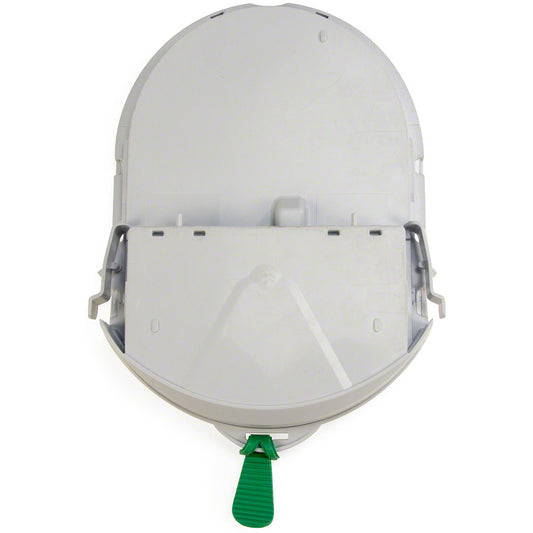
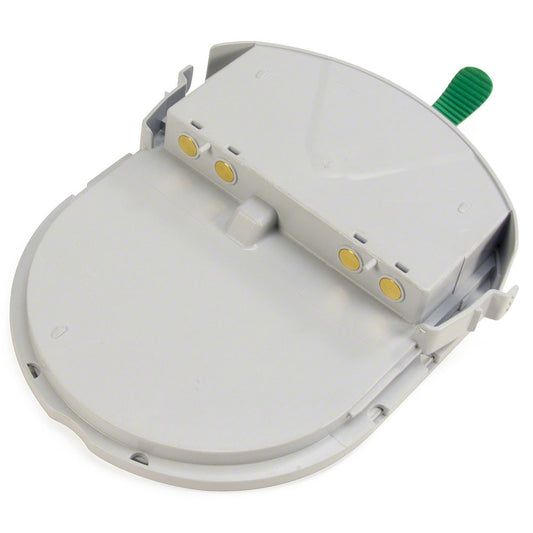
Samaritan Pad Pak 01 AED Cartridge & Battery for Adults
<h2><strong>Response Ready: HeartSine Samaritan Pad Pak 01 – Defibrillator Convenience Redefined</strong></h2> <p><em>Key Features:</em></p> <ul> <li> <strong>All-in-One Convenience:</strong> The Pad Pak 01 combines replacement pads and a battery, streamlining maintenance.</li> <li> <strong>Extended Shelf Life:</strong> Enjoy a prolonged 4-year lifespan from the time of manufacture, surpassing standard AED pads.</li> </ul> <p><em>Compatible AED Models:</em></p> <ul> <li>Designed for HeartSine Samaritan AEDs: <ul> <li><a href="/product/heartsine-samaritan-pad-350p/">HeartSine Samaritan Pad 350P</a></li> <li><a href="/product/heartsine-samaritan-pad-360p/">HeartSine Samaritan Pad 360P</a></li> <li><a href="/product/heartsine-samaritan-pad-450p/">HeartSine Samaritan Pad 450P</a></li> </ul> </li> </ul> <p><em>Suitable for:</em></p> <ul> <li>Patients over 8 years old and above 55 pounds.</li> </ul> <p><em>How to Replace:</em></p> <ol> <li> <strong>Remove AED from Case:</strong> <ul> <li>Safely extract the HeartSine Pad Pak AED from its case.</li> </ul> </li> <li> <strong>Dispose of Old Cartridge:</strong> <ul> <li>Press and hold the tabs, slide out the old Pad Pak, and dispose of it.</li> </ul> </li> <li> <strong>Note Expiration Date:</strong> <ul> <li>Record the expiration date found on the front of the new Pad Pak.</li> </ul> </li> <li> <strong>Install New Pad Pak:</strong> <ul> <li>Lay the AED and new Pad Pak on a flat surface.</li> <li>Slide the new Pad Pak into the chamber until a click is heard.</li> <li>Ensure the flat portion faces down for a secure fit.</li> <li>Confirm a successful connection with the green readiness light.</li> </ul> </li> </ol> <h4>Video tutorial on replacing pads for HeartSine Samaritan AED devices.</h4> <p><iframe src="https://www.youtube.com/embed/xctL6wPBAVc" width="560" height="315" frameborder="0" allowfullscreen="allowfullscreen"></iframe></p> <h2>Why Choose Response Ready?</h2> <ul> <li>Simplify maintenance with an all-in-one solution.</li> <li>Benefit from an extended 4-year shelf life.</li> <li>Ensure prompt shipping and low prices.</li> </ul> <p><em>Order Your HeartSine Pad Pak Today:</em></p> <ul> <li>Whether replacing an expiring cartridge or stocking up, Response Ready is your trusted source.</li> <li>Experience convenience and reliability in defibrillator maintenance.</li> </ul> <p>Replace the hassle with efficiency – Choose Response Ready for your HeartSine <a href="/product/heartsine-samaritan-pediatric-pad-pak-pads-battery/">Samaritan Pad Pak</a> needs.</p>
Samaritan Pad Pak 01 AED Cartridge & Battery for Adults
view productRegular price $236.00Regular priceUnit price / per -
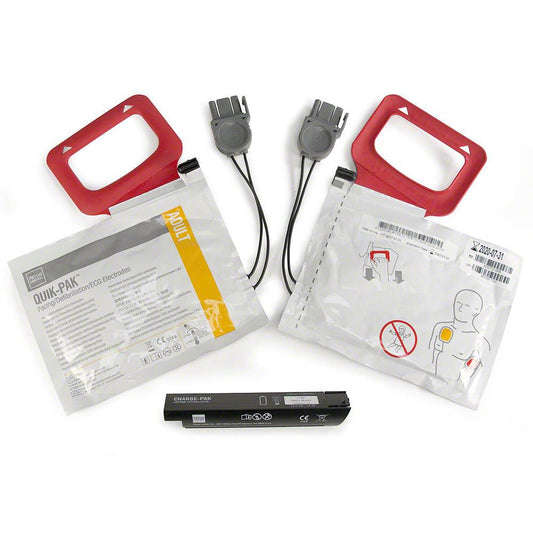
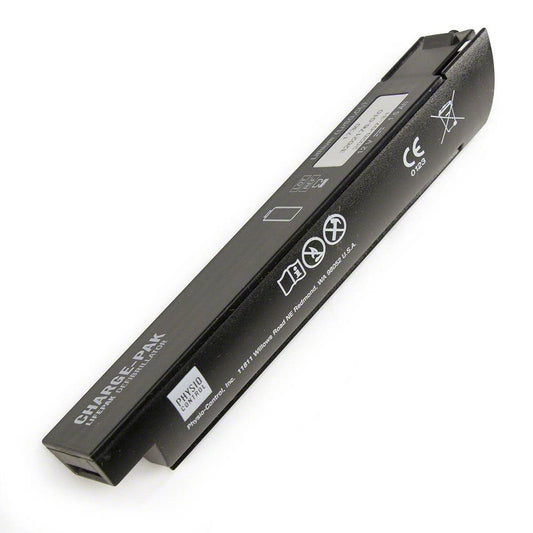
CR Plus/EXPRESS AED Battery & Pads (2 Sets)
<h2><strong>Response Ready: LIFEPAK CR Plus AED Battery & Pads Set</strong></h2> <p><em>Empower Your Lifesaving AED Program</em></p> <p>Equip your LIFEPAK CR Plus and LIFEPAK EXPRESS AED with the essential tools for saving lives. Response Ready proudly presents the Physio Control LIFEPAK CR Plus AED Battery & Pads Set, ensuring your AED program is robust and ready to respond.</p> <p><strong>Key Features:</strong></p> <ul> <li>Fully Automatic: Requires only two steps for quick and efficient use.</li> <li>Complete Set: Includes two sets of adult pads and a battery charger.</li> <li>Safe Disposal: Features a discharger for proper disposal of used CHARGE-PAK.</li> <li>Maintenance Essential: Keep your AED program compliant with regular inspections.</li> </ul> <p><strong>Why Choose the CR Plus AED Battery & Pads Set?</strong></p> <ul> <li>Finite Shelf Life: AED pads, like batteries, have a limited shelf life and eventually expire.</li> <li>Program Compliance: Ensure your AED program meets regulatory standards.</li> <li>Rapid Response: Immediate access to backup batteries and pads can be crucial in emergencies.</li> </ul> <p><strong>Statistics Matter:</strong></p> <ul> <li>350,000 – 400,000 Americans face sudden cardiac arrest (SCA) annually.</li> <li>Time is Critical: AED usage within 3 – 5 minutes significantly improves survival rates.</li> </ul> <p><strong>Don't Compromise Safety:</strong></p> <ul> <li>Safeguard your business, learning institution, entertainment venue, or worship place.</li> <li>Establish a robust AED program with all necessary components in place.</li> </ul> <p><strong>Order Your Response Ready Set Today:</strong></p> <ul> <li>Ensure your AED is always ready to respond.</li> <li>Invest in safety, invest in preparedness.</li> <li>Don't let a moment pass – act now to save lives.</li> </ul> <p>Choose Response Ready for your AED needs. Order the LIFEPAK CR Plus AED Battery & Pads Set today.</p> <p> </p> <div style="float: left; width: 49%;"> <h3>Replacing the Pads on a Physio Control Lifepak CR Plus AED Device</h3> <p><iframe src="https://www.youtube.com/embed/OZGrTsc6EQA" width="560" height="315" frameborder="0" allowfullscreen="allowfullscreen"></iframe></p> </div> <div style="float: right; width: 49%;"> <h3>Replacing the Charge Pack on Physio Control Lifepak CR Plus AED Devices - Step by Step Guide</h3> <p><iframe src="https://www.youtube.com/embed/vfwm80JVIEg" width="560" height="315" frameborder="0" allowfullscreen="allowfullscreen"></iframe></p> </div>
CR Plus/EXPRESS AED Battery & Pads (2 Sets)
view productRegular price $527.00Regular priceUnit price / per -
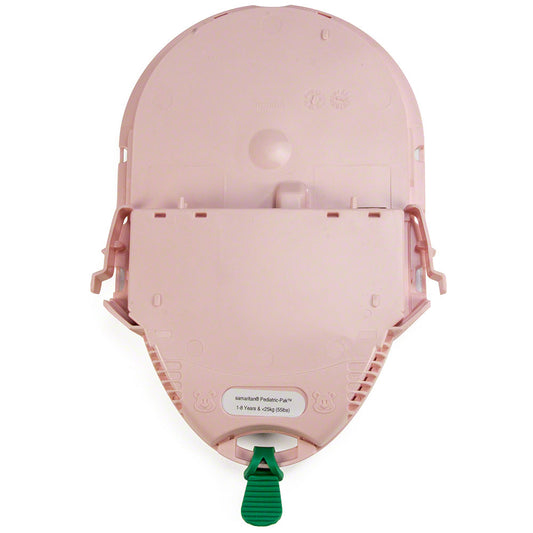
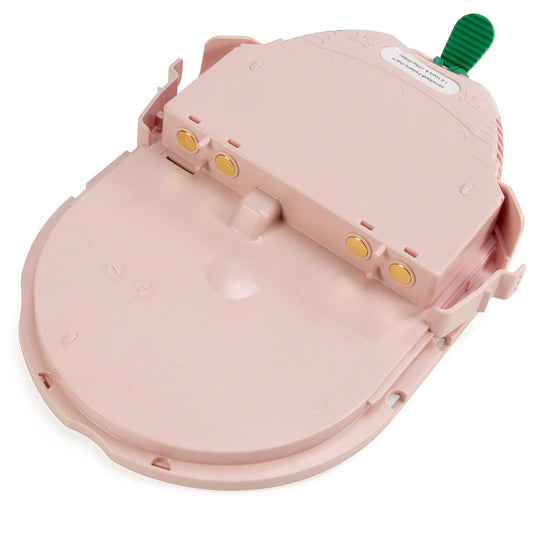
HeartSine Samaritan Pediatric Pad-Pak (Pads & Battery)
<h2><strong>Response Ready: HeartSine Samaritan Pediatric Pad Pak</strong></h2> <p>Ensure the utmost preparedness for pediatric cardiac emergencies with the HeartSine <a href="/product/samaritan-pad-pak-01-aed-cartridge-battery-for-adults/">Samaritan Pediatric Pad Pak</a>, a comprehensive solution that integrates AED pads and batteries into a single cartridge.</p> <p><strong>Key Features:</strong></p> <ul> <li> <strong>Pediatric Specific:</strong> Tailored for cardiac arrest patients under 55 pounds and 8 years of age.</li> <li> <strong>Smart Compatibility:</strong> Signals compatible HeartSine AEDs to adjust electric shock levels for small children.</li> <li> <strong>Versatile Models:</strong> Compatible with <a href="/product/heartsine-samaritan-pad-350p/">HeartSine Samaritan Pad 350P</a>, <a href="/product/heartsine-samaritan-pad-360p/">360P</a>, and <a href="/product/heartsine-samaritan-pad-450p/">450P</a> defibrillator models.</li> </ul> <p><strong>Easy Installation & Usage:</strong></p> <ul> <li> <strong>Emergency Swap:</strong> In case of an emergency, seamlessly swap the adult cartridge with the child cartridge by pressing tabs and sliding it into the chamber.</li> <li> <strong>Visual Confirmation:</strong> The click sound and green readiness light confirm the successful installation, ensuring a quick response.</li> </ul> <p><strong>Simple Application:</strong></p> <ul> <li> <strong>Pad Placement:</strong> Peel each pad and adhere to the child's bare skin, following the visual diagram – one on the chest center and the other on the back center.</li> </ul> <p><strong>Durable & Reliable Design:</strong></p> <ul> <li> <strong>Extended Lifespan:</strong> The durable Samaritan Pad-Pak boasts a 4-year lifespan, double that of standard AED pads and batteries.</li> <li> <strong>Expiration Information:</strong> Clearly printed expiration date on the front for easy tracking and replacement planning.</li> </ul> <p><strong>Life-Saving Investment:</strong></p> <ul> <li> <strong>Cost-Effective:</strong> With a low cost of ownership, this pediatric cartridge is a crucial accessory for HeartSine defibrillators.</li> <li> <strong>State-of-the-Art Design:</strong> Designed to contribute to saving lives with advanced features and reliability.</li> </ul> <p><strong>Order Your HeartSine Samaritan Pad-Pak Today:</strong></p> <ul> <li> <strong>Critical Accessory:</strong> With over 2,000 children in the U.S. succumbing to sudden cardiac arrest annually, the Samaritan Pad-Pak is an indispensable accessory.</li> <li> <strong>Exclusive Offer:</strong> Order your HeartSine Pad-Pak from Response Ready and benefit from free shipping along with our low-price guarantee.</li> </ul> <h3>Replacing Pads on HeartSine Samaritan AED Devices - Pad-Pak Replacement</h3> <p><iframe src="https://www.youtube.com/embed/xctL6wPBAVc" width="560" height="315" frameborder="0" allowfullscreen="allowfullscreen"></iframe></p> <div class="tabContent"> <p><strong>Be Response Ready – Act Now:</strong> The HeartSine Samaritan Pediatric Pad Pak is your assurance against pediatric cardiac emergencies. Order now from Response Ready, your trusted source for AED solutions.</p> <p><em>For inquiries or assistance, contact us. Your preparedness is our commitment.</em></p> </div>
HeartSine Samaritan Pediatric Pad-Pak (Pads & Battery)
view productRegular price $279.00Regular priceUnit price / per -
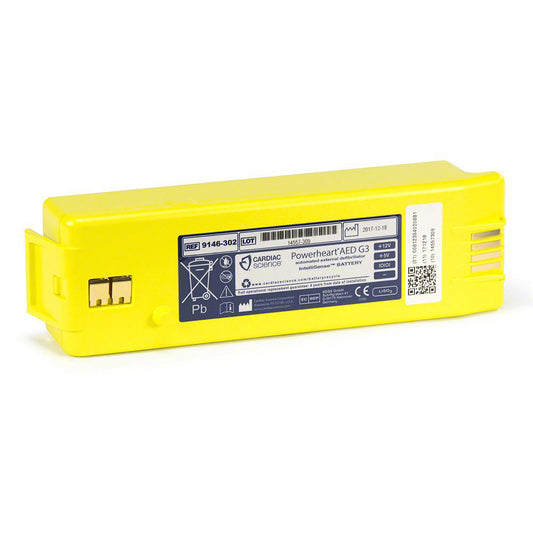
Cardiac Science Powerheart AED G3 Battery (9146-302)
<h2><strong>Response Ready: Cardiac Science Powerheart G3 AED Battery (Part Number 9146-302)</strong></h2> <p>Elevate the readiness of your Powerheart G3 AED with our medical-grade replacement battery, designed specifically for the G3 AED device. The Cardiac Science Intellisense battery, featuring Rescue Ready technology, establishes seamless communication with your G3 defibrillator, conveying crucial battery performance, capacity, and vital information.</p> <p><strong>Key Features:</strong></p> <ul> <li> <strong>Daily Self-Testing:</strong> The original G3 AED battery undergoes daily self-tests to ensure continuous readiness for sudden cardiac arrest emergencies.</li> <li> <strong>Four-Year Performance Guarantee:</strong> Each Intellisense® battery is backed by a four-year performance guarantee, providing long-lasting reliability.</li> <li> <strong>State-of-the-Art Technologies:</strong> Renowned for STAR Biphasic and RescueCoach technologies, the Powerheart G3 AED is a life-saving marvel.</li> </ul> <p><strong>Original PowerHeart G3 AED Replacement Battery:</strong></p> <ul> <li> <strong>Longevity:</strong> Boasting a life of four years from the date of manufacture, ensuring extended reliability.</li> <li> <strong>Recyclable:</strong> As a lithium battery, proper recycling is recommended. Utilize battery-recycling drop-off locations in your area.</li> </ul> <p><strong>Compatibility:</strong></p> <ul> <li>Intended for use with Powerheart G3 defibrillators: 9300E, 9300A, 9390E, and 9390A.</li> <li>The G3 AED device conducts daily self-tests to ensure software, hardware, pads, and battery are in optimal condition.</li> </ul> <p><strong>Why Choose Genuine Cardiac Science Parts:</strong></p> <ul> <li> <strong>Manufacturer Assurance:</strong> This is an authentic Cardiac Science Powerheart AED G3 replacement battery from the manufacturer.</li> <li> <strong>Warranty Protection:</strong> Purchasing authorized manufacturer parts ensures the integrity of your Cardiac Science warranty.</li> <li> <strong>Reliable Source:</strong> AED Leader is your trusted provider of genuine <a href="/">AED devices</a> and accessories.</li> </ul> <p><strong>Order with Confidence from Response Ready:</strong></p> <ul> <li> <strong>Authorized Distributor:</strong> As an authorized Cardiac Science distributor, we deliver authentic and reliable products.</li> <li> <strong>Free Shipping:</strong> Enjoy free shipping on all orders over $99, making it convenient for you to maintain your AED's readiness.</li> <li> <strong>Emergency-Ready Assurance:</strong> Keep a spare battery on hand to ensure your defibrillator is always ready for emergencies.</li> </ul> <p><strong>Ensure the Lifespan of Your AED – Order Today:</strong> Choose Response Ready for your Cardiac Science Powerheart G3 AED replacement battery. Order now to experience top-tier reliability and ensure your AED is always prepared for life-saving action.</p> <p><em>For inquiries or assistance, contact us. Your AED readiness is our priority.</em></p>
Cardiac Science Powerheart AED G3 Battery (9146-302)
view productRegular price $499.00Regular priceUnit price / per -

Philips FRx Aviation Battery (TSO C-142)
<div align="center"> <span style="color: #c00000; font-size: x-large;"><strong><em>Attention!</em></strong></span><strong> AED PADS EXPIRE</strong> </div> <div align="center">Ensure compliance by replacing your pads before they expire.</div> <div align="center">Choose your FRx AED pads from the options below to make a purchase.</div> <p> </p> <h2><strong>Elevate Aircraft Safety with Philips FRx Aviation Battery from Response Ready</strong></h2> <p>Upgrade your aircraft's emergency response capabilities with the official <a href="/product/philips-heartstart-frx-aed-861304/">Philips FRx</a> aviation battery, meticulously crafted for personal and commercial aircraft. Designed for use with the versatile Philips FRx AED, this aviation battery ensures readiness and reliability at any altitude. Secure your aviation battery from Response Ready, your trusted authorized Philips distributor.</p> <p><strong>Key Features:</strong></p> <ul> <li> <strong>TSO C-142 Compliance:</strong> Meets FAA's TSO-C142 technical standard, approved for aircraft use, ensuring optimal performance at high elevations.</li> <li> <strong>Factory-Authorized OEM Battery:</strong> Safeguard your AED with the assurance of a factory-authorized, genuine Philips aviation battery. Avoid third-party batteries to mitigate health and performance risks.</li> </ul> <p><strong>Long-Lasting Performance:</strong></p> <ul> <li> <strong>Extended Shelf Life:</strong> Lithium manganese dioxide battery boasts an industry-leading five-year shelf life.</li> <li> <strong>Sturdy Standby Life:</strong> With an average four-year standby life, the battery is ready when you need it.</li> <li> <strong>High-Shock Capacity:</strong> Provides a full 200 shocks or 4 hours of operation, delivering reliable performance during critical moments.</li> </ul> <p><strong>Installation Confidence:</strong></p> <ul> <li> <strong>Printed Install-By Date:</strong> Each battery includes a labeled install-by date for optimal performance.</li> <li> <strong>Prevent Premature Degradation:</strong> Avoid using standard FRx batteries at high altitudes, as reduced oxygen may impact battery life.</li> </ul> <p><strong>Order Your Aircraft AED Battery Today:</strong> Ensure compliance and preparedness in the skies:</p> <ul> <li>FAA recommends AEDs on airplanes exceeding 7,500 pounds payload capacity.</li> <li>Even if not mandated, having a TSO C-142 compliant defibrillator is prudent for passenger aircraft.</li> </ul> <p><strong>Exclusive Offer from Response Ready:</strong> Take advantage of free shipping on this long-lasting aviation battery. Elevate your aircraft safety measures by ordering your Philips FRx Aviation Battery today and experience peace of mind in the skies.</p>
Philips FRx Aviation Battery (TSO C-142)
view productRegular price $210.00Regular priceUnit price / per -

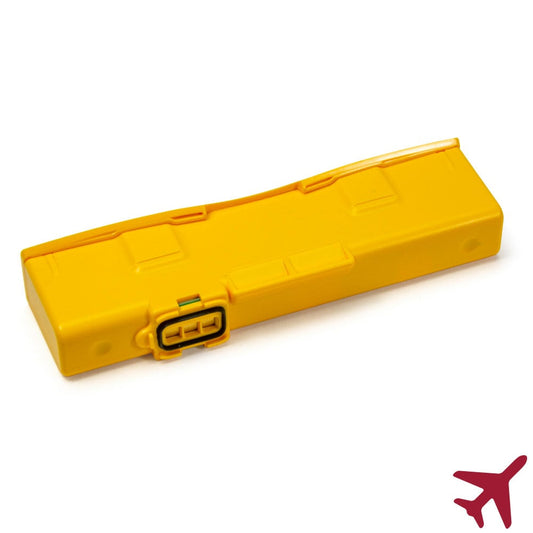
Aviation Battery for Defibtech Lifeline VIEW/ECG/PRO AEDs
<h2><strong>Explore the Defibtech Lifeline VIEW (2000 Series) Standard 4-Year Battery Pack - FAA Approved</strong></h2> <p><strong>Elevate Your AED Performance with Defibtech Lifeline VIEW:</strong></p> <p>Unleash the potential of the Defibtech Lifeline VIEW (2000 Series) Standard 4-Year Battery Pack, now FAA approved. Here’s why it stands out:</p> <p><strong>Compact and Portable:</strong></p> <ul> <li>Designed for ease of use and portability.</li> <li>Compact size for convenient storage and transport.</li> </ul> <p><strong>FAA Approved for Air Travel:</strong></p> <ul> <li>Complies with FAA regulations for in-flight use.</li> <li>Ideal for individuals who require AED support during air travel.</li> </ul> <p><strong>Extended Battery Life:</strong></p> <ul> <li>Standard 4-Year Battery Pack ensures long-lasting reliability.</li> <li>Eliminates the need for frequent battery replacements.</li> </ul> <p><strong>Seamless Integration with Lifeline VIEW AED:</strong></p> <ul> <li>Specifically designed for compatibility with Lifeline VIEW (2000 Series).</li> <li>Ensures optimal performance and functionality.</li> </ul> <p><strong>Why Response Ready for Your Defibtech Needs:</strong></p> <p>Choose Response Ready as your trusted supplier for Defibtech products:</p> <p><strong>Authorized Distributor:</strong></p> <ul> <li>Source Defibtech products from an authorized distributor.</li> <li>Guaranteeing authenticity and quality assurance.</li> </ul> <p><strong>Competitive Pricing:</strong></p> <ul> <li>Enjoy competitive pricing without compromising on quality.</li> <li>Affordable solutions for your AED requirements.</li> </ul> <p><strong>Efficient Shipping:</strong></p> <ul> <li>Swift and efficient shipping to meet your urgent needs.</li> <li>Hassle-free delivery right to your doorstep.</li> </ul> <p><strong>Upgrade Your AED with Response Ready:</strong></p> <p>Make the smart choice for AED accessories. Order the Defibtech Lifeline VIEW (2000 Series) Standard 4-Year Battery Pack from Response Ready today. Elevate your preparedness for emergencies with reliable, FAA-approved AED solutions.</p>
Aviation Battery for Defibtech Lifeline VIEW/ECG/PRO AEDs
view productRegular price $253.90Regular priceUnit price / per -
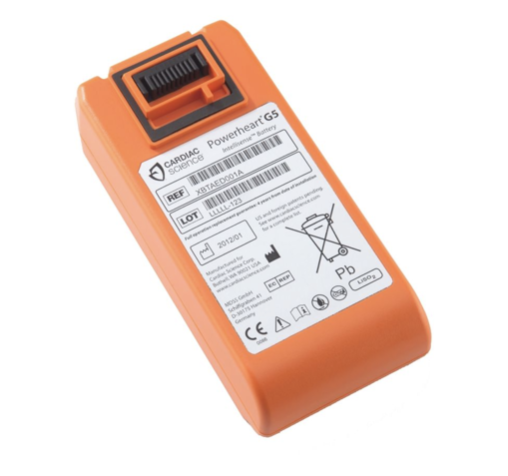
Cardiac Science Powerheart G5 Replacement Battery
<h2><strong>Elevate Your Cardiac Science Powerheart G5 with the Ultimate Replacement Battery from Response Ready!</strong></h2> <p>Ensure your <a href="/product/cardiac-science-powerheart-g5-aed/">Powerheart G5 AED</a> is always ready for action with our premium replacement battery. Engineered for optimal performance, this lithium IntelliSense battery (part number XBTAED001A) is designed to last a full four years, backed by a manufacturer’s operational guarantee. Trust Response Ready for the power you can rely on in critical moments.</p> <p><strong>Key Features:</strong></p> <ol> <li> <strong>Extended Lifespan:</strong> <ul> <li>Designed for a full four years of reliable use.</li> <li>Ensures longevity and dependability in emergencies.</li> </ul> </li> <li> <strong>Medical-Grade Construction:</strong> <ul> <li>Crafted with precision for medical-grade quality.</li> <li>Rigorously tested to meet the highest standards of performance.</li> </ul> </li> <li> <strong>Exclusive Compatibility:</strong> <ul> <li>Tailored specifically for Cardiac Science Powerheart G5 AED devices.</li> <li>Seamless integration for a hassle-free replacement process.</li> </ul> </li> <li> <strong>Rescue Ready® Technology:</strong> <ul> <li>Patented technology communicates vital information to your AED.</li> <li>Monitors condition, age, storage temperature, and more for instant alerts.</li> </ul> </li> <li> <strong>Four-Year Manufacturer Guarantee:</strong> <ul> <li>Backed by a comprehensive operational guarantee for peace of mind.</li> <li>Assurance of quality and performance from the manufacturer.</li> </ul> </li> </ol> <h3>Why Choose Response Ready:</h3> <ul> <li> <strong>Authorized Distributor:</strong> As a trusted distributor of <a href="/product/cardiac-science-powerheart-g5-aed/">Cardiac Science AEDs</a>, Response Ready ensures genuine, factory-authorized batteries.</li> <li> <strong>Money-Back Guarantee:</strong> Our commitment to quality is backed by a 100% money-back guarantee.</li> <li> <strong>Free Shipping:</strong> Enjoy free shipping on orders exceeding $99.</li> </ul> <p><strong>Stay Prepared – Order Your Cardiac Science G5 Battery Today!</strong></p> <p>Don't compromise on your AED's performance. Choose Response Ready for the official Cardiac Science G5 replacement battery. Trust in our expertise, and ensure your AED is equipped for life-saving action. Order now!</p>
Cardiac Science Powerheart G5 Replacement Battery
view productRegular price $495.00Regular priceUnit price / per
AED PADS
-
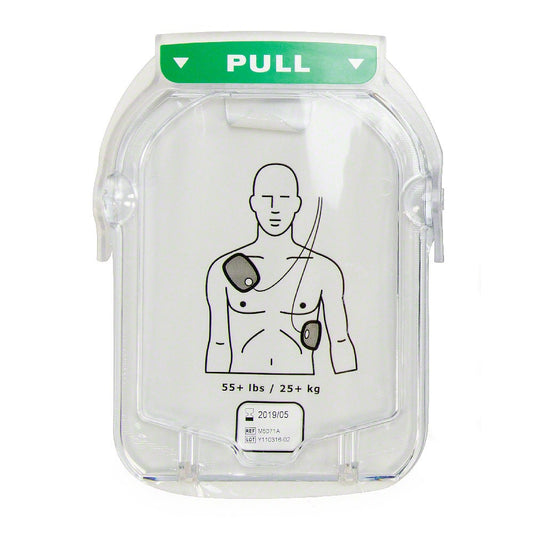

Philips HeartStart Pads for Onsite AED M5071A
<h2><strong>Philips HeartStart Onsite Adult SMART AED Pads (Model M5071A) – Swift and Reliable Life Support</strong></h2> <p><strong>Key Features:</strong></p> <ul> <li> <strong>Designed for Adults:</strong> Specifically crafted for victims aged 8 years and older, weighing at least 55 pounds.</li> <li> <strong>SMART Design:</strong> Equipped with intuitive adapters for seamless connection to the AED, ensuring prompt and efficient application during emergencies.</li> <li> <strong>Easy Application:</strong> Pull down the handle to reveal the pads, and follow the simple diagram for precise placement on the patient’s chest.</li> <li> <strong>Expiration Alert:</strong> SMART technology detects when opened and attached, prompting immediate rhythm assessment without delays.</li> <li> <strong>Two-Year Shelf Life:</strong> Each set has a 2-year shelf life, guaranteeing freshness and effectiveness when needed the most.</li> <li> <strong>Replacement Recommendation:</strong> If nearing the expiration date, invest in a replacement set to ensure optimal performance during emergencies.</li> <li> <strong>Backup Set Benefits:</strong> For continuous preparedness, having a backup set is crucial in case of expiration or usage during an emergency.</li> </ul> <p><strong>Why Choose Philips HeartStart Pads from Response Ready:</strong></p> <ul> <li> <strong>Authorized Distributor:</strong> Formerly AED Leader, Response Ready ensures the authenticity and reliability of <a href="/product/philips-heartstart-pediatric-pads-m5072a/">Philips HeartStart Pads</a>.</li> <li> <strong>Swift Shipping:</strong> Order today for quick delivery, ensuring you are always prepared for unexpected cardiac events.</li> </ul> <p><strong>Take Action – Order Your Philips HeartStart Pads Now!</strong></p> <p><em>Be prepared, be confident – Choose Response Ready for your life-saving equipment.</em></p> <p><em>Model Number: M5071A</em></p>
Philips HeartStart Pads for Onsite AED M5071A
view productRegular price $89.00Regular priceUnit price / per -
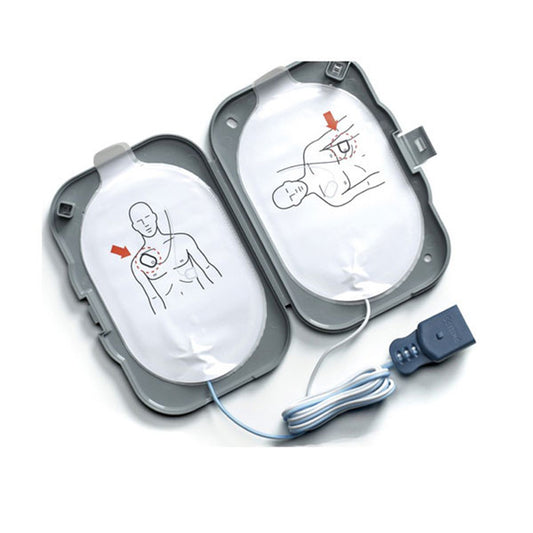
Philips HeartStart SMART Pads II for FRx AED
<h2><strong>Response Ready: Philips FRx SMART Pads II – Swift, Intuitive, and Compact</strong></h2> <p>Elevate your AED readiness with the Response Ready <a href="/product/philips-heartstart-frx-aed-861304/">Philips FRx</a> SMART Pads II. Designed for use with the Philips FRx AED device, these pre-connected pads ensure a rapid response in emergencies. Compact, intuitive, and featuring advanced technology, these pads are a crucial addition to your life-saving toolkit.</p> <p><strong>Key Features:</strong></p> <ul> <li> <strong>Easy Deployment:</strong> Always pre-connected to the AED for immediate use, these pads enable quick attachment to the patient's chest during a cardiac emergency.</li> <li> <strong>Intelligent Technology:</strong> SMART Pads II detect attachment to the chest, providing instant heart rhythm assessments to the defibrillator. This accelerates response time, ensuring timely and effective electrical shocks if needed.</li> <li> <strong>Compact Design:</strong> Weighing only 0.15 lbs and measuring 10 × 6.5 × 10 in, these pads integrate seamlessly with the defibrillator, adding minimal weight to the case.</li> </ul> <p><strong>How to Use Philips FRx SMART Pads II:</strong></p> <ol> <li>Attach the pre-connected SMART Pads adapter to the AED.</li> <li>Turn on the defibrillator using the Green "Power" button.</li> <li>Peel the pads from the casings, exposing the adhesive side.</li> <li>Apply the pads firmly to the patient's chest following the placement diagram.</li> <li>Follow audible instructions from the FRx defibrillator. Press the "Shock" button only if prompted, avoiding contact with the patient during shocks.</li> </ol> <p><strong>Order Your Philips FRx SMART Pads II Today</strong></p> <p>Ensure preparedness by having an extra set of SMART Pads II for emergencies. Order from Response Ready today and benefit from our one-year low-price protection and a 100% moneyback guarantee. Act now to enhance your life-saving capabilities.</p> <p><em>Wholesale pricing available for large-quantity orders. Inquire on our <a href="https://responseready.com/pages/wholesale-aeds/">wholesale page</a>.</em></p>
Philips HeartStart SMART Pads II for FRx AED
view productRegular price $69.00Regular priceUnit price / per -
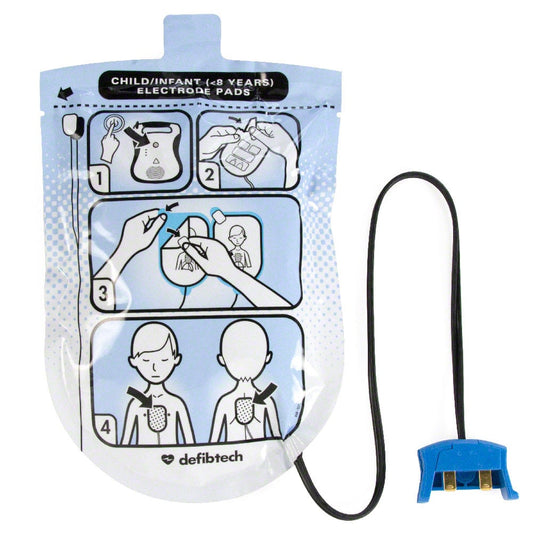
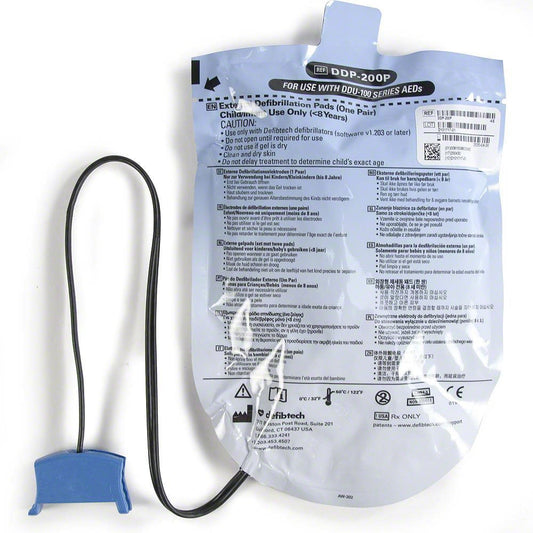
Defibtech Lifeline AED Pediatric Pads
<h2><strong>Enhance Preparedness with Defibtech Lifeline AED Pediatric Pads - A Critical Addition for Child Safety</strong></h2> <p><strong>Unveiling Pediatric Pads for Defibtech Lifeline AED:</strong></p> <p>Ensure comprehensive AED readiness with the specially designed Pediatric Pads for Defibtech Lifeline AED. These pads cater specifically to the unique needs of children during cardiac emergencies. Here's why they are an essential addition to your life-saving toolkit:</p> <p><strong>Tailored for Pediatric Use:</strong></p> <ul> <li>Customized for application on children, addressing their distinct physiology.</li> <li>A vital component for responding to cardiac incidents involving young patients.</li> </ul> <p><strong>User-Friendly Integration:</strong></p> <ul> <li>Seamlessly integrates with the Defibtech Lifeline AED for intuitive use.</li> <li>Simplifies the process of transitioning the AED for pediatric treatment.</li> </ul> <p><strong>Optimized Shock Delivery:</strong></p> <ul> <li>Ensures that the level of shock administered is calibrated for pediatric patients.</li> <li>Mitigates risks associated with using adult-sized pads on children.</li> </ul> <p><strong>Key Benefits of Choosing Response Ready:</strong></p> <p>Experience unparalleled service and reliability when you choose Response Ready for your AED needs:</p> <p><strong>Authorized Supplier:</strong></p> <ul> <li>Source pediatric pads from an authorized distributor.</li> <li>Guaranteeing authenticity and adherence to quality standards.</li> </ul> <p><strong>Competitive Pricing:</strong></p> <ul> <li>Benefit from competitive pricing without compromising quality.</li> <li>Affordable solutions for upgrading your AED capabilities.</li> </ul> <p><strong>Efficient Shipping:</strong></p> <ul> <li>Swift and efficient shipping to meet your urgent requirements.</li> <li>Ensures your pediatric pads are readily available when needed.</li> </ul> <p><strong>Elevate Your AED Capabilities with Response Ready:</strong></p> <p>Make the prudent choice for pediatric AED accessories. Order the Defibtech Lifeline AED Pediatric Pads from Response Ready today. Elevate your preparedness for emergencies involving children with reliable, purpose-built AED solutions.</p>
Defibtech Lifeline AED Pediatric Pads
view productRegular price $130.25Regular priceUnit price / per -
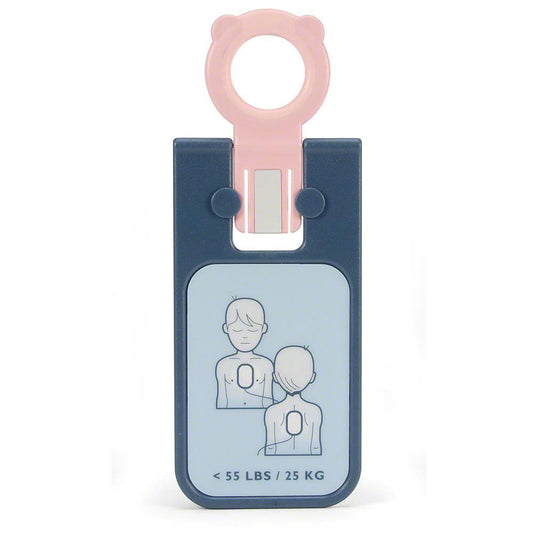
Philips HeartStart FRx Infant Child Pediatric Key
<h2><strong>Response Ready: FRx Infant/Child Key – Effortless Pediatric Compatibility</strong></h2> <p>Unlock pediatric life-saving capabilities with the Response Ready FRx Infant/Child Key. This key eliminates the need for separate pediatric pads, ensuring a seamless transition to pediatric mode in your FRx AED. Experience tailored care for young patients with reduced energy delivery and specialized voice prompts.</p> <p><strong>Key Features:</strong></p> <ul> <li> <strong>Pediatric Compatibility:</strong> The FRx Infant/Child Key seamlessly adapts your AED to pediatric mode, eliminating the requirement for additional pediatric pads.</li> <li> <strong>Automated Activation:</strong> Insert the key, and the AED instantly adjusts settings for pediatric care, streamlining the process during critical moments.</li> <li> <strong>Energy Reduction:</strong> In pediatric mode, the FRx delivers reduced energy suitable for children under 55 lbs or those younger than 8 years old.</li> <li> <strong>Voice Guidance:</strong> Benefit from specific voice prompts designed to guide users through pediatric resuscitation, ensuring optimal care.</li> </ul> <p><strong>Order Your FRx Infant/Child Key Today</strong></p> <p>Enhance your AED's versatility with the Response Ready FRx Infant/Child Key. Make the smart choice for pediatric care – order now and ensure readiness for all life-saving scenarios.</p> <p><em>Wholesale pricing available for large-quantity orders. Inquire on our <a href="https://responseready.com/pages/wholesale-aeds/">wholesale page</a>.</em></p>
Philips HeartStart FRx Infant Child Pediatric Key
view productRegular price $121.00Regular priceUnit price / per -


Lifepak CR2 Adult/child Quik-step Pads
<p><meta charset="utf-8"><span>The </span><span class="s1"><b>LIFEPAK CR2 Adult Child Quik Step Pads</b></span><span> are designed for use with the LIFEPAK CR2 AED from Stryker. These combination adult and pediatric pads include a cover and replacement instructions for simple setup and quick replacement. Compatible with the CR2’s child mode and bilingual functions they ensure reliable performance and readiness in any emergency.</span></p>
Lifepak CR2 Adult/child Quik-step Pads
view productRegular price $196.00Regular priceUnit price / per -
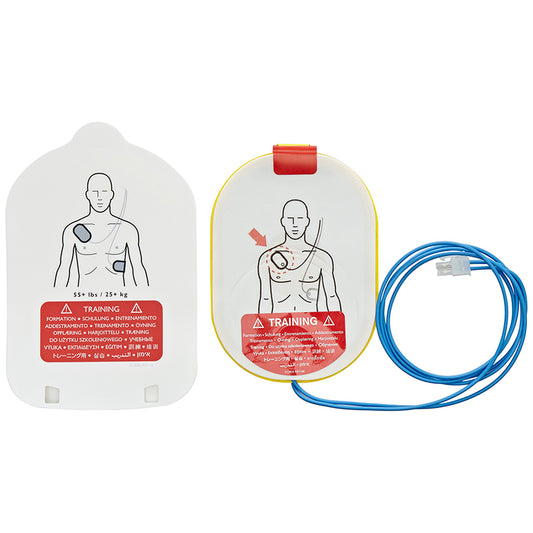
OnSite Adult TRAINING Pads
<h2><strong>Response Ready Adult Training Electrode Pads for Philips OnSite Training Unit</strong></h2> <p>Revitalize your training sessions with Response Ready Adult Training Electrode Pads, meticulously crafted for use with the <a href="/product/philips-heartstart-onsite-aed-defibrillator-m5066a/">Philips OnSite</a> Training Unit. Elevate your emergency response practice with these high-quality pads designed for realistic and effective AED training.</p> <p><strong>Key Features:</strong></p> <ul> <li> <strong>Optimized Training Experience:</strong> <ul> <li>Precision-engineered for lifelike AED scenarios during training.</li> <li>Enhances skills in responding to adult cardiac emergencies.</li> </ul> </li> <li> <strong>Seamless Integration:</strong> <ul> <li>Specifically designed for easy compatibility with the Philips OnSite Training Unit.</li> <li>Effortless pad replacement for uninterrupted training sessions.</li> </ul> </li> <li> <strong>Durable Design:</strong> <ul> <li>Long-lasting construction for extended usability.</li> <li>Withstands repeated use to ensure cost-effective training.</li> </ul> </li> </ul> <p><strong>Benefits of Response Ready Adult Training Electrode Pads:</strong></p> <ul> <li> <strong>Realistic Simulation:</strong> <ul> <li>Simulates authentic adult rescue scenarios for practical training.</li> <li>Boosts confidence in responding to diverse cardiac emergencies.</li> </ul> </li> <li> <strong>User-Friendly Replacement:</strong> <ul> <li>Intuitive design for quick and hassle-free pad replacement.</li> <li>Streamlines the training process for a more efficient experience.</li> </ul> </li> <li> <strong>Cost-Effective Training Solution:</strong> <ul> <li>Reusable pads for ongoing and economical training needs.</li> <li>Ensures a sustainable and value-driven training investment.</li> </ul> </li> </ul> <p>Equip your training environment with Response Ready Adult Training Electrode Pads – the essential component for honing life-saving skills with the Philips OnSite Training Unit. Be prepared, be confident, and be response-ready in any cardiac emergency scenario.</p>
OnSite Adult TRAINING Pads
view productRegular price $55.00Regular priceUnit price / per -
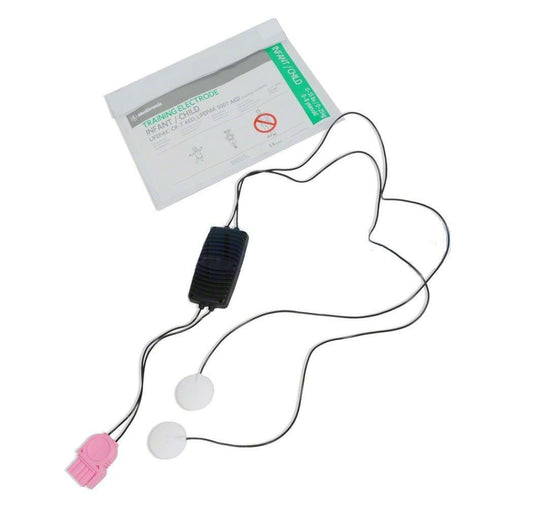
LIFEPAK 500/CR Plus Cable/Connector Assembly/Pouch for Infant/Child AED Training Pads
<h2><strong>Refresh Your Training Gear with Response Ready Infant/Child Training Pad Accessories</strong></h2> <p>Revitalize your CPR and AED training sessions with the Response Ready Replacement Reusable Pouch and Cable Connector Assembly. Specifically crafted for use with LIFEPAK infant/child training pads, this accessory ensures seamless compatibility with CR Plus and LIFEPAK 500 trainers. Elevate your training experience with durable and reliable components designed to simulate real-life scenarios.</p> <p><strong>Key Features:</strong></p> <ul> <li> <strong>Versatile Compatibility:</strong> Tailored for use with LIFEPAK infant/child training pads, ensuring optimal compatibility.</li> <li> <strong>Enhanced Training Realism:</strong> Replicates the functionality of actual AED pads for a lifelike training experience.</li> <li> <strong>Durable Construction:</strong> Designed for repeated use, offering long-lasting durability to withstand rigorous training sessions.</li> <li> <strong>Effortless Connectivity:</strong> User-friendly cable connector assembly for hassle-free integration with CR Plus and LIFEPAK 500 trainers.</li> <li> <strong>Training Pads Sold Separately:</strong> Note that training pads are not included, allowing you to customize your training setup based on your specific needs.</li> </ul> <p><strong>Benefits of Response Ready Training Accessories:</strong></p> <ul> <li> <strong>Realistic Simulation:</strong> Mimics the performance of genuine AED pads, providing a realistic training environment.</li> <li> <strong>Cost-Effective Solution:</strong> Economical choice for extending the lifespan of your training accessories without compromising quality.</li> <li> <strong>Reliable and Reusable:</strong> Sturdy construction supports multiple uses, reducing the need for frequent replacements.</li> <li> <strong>User-Friendly Design:</strong> Effortless assembly ensures a quick and efficient setup for your training sessions.</li> <li> <strong>Tailored for Specific Models:</strong> Engineered for seamless integration with CR Plus and LIFEPAK 500 trainers, ensuring compatibility.</li> </ul> <p>Elevate your training initiatives with Response Ready Infant/Child Training Pad Accessories. Invest in quality, durability, and realism for effective CPR and AED training.</p> <p><em>Wholesale pricing available for large-quantity orders. Please inquire on our <a href="https://responseready.com/pages/wholesale-aeds/">wholesale page</a>.</em></p>
LIFEPAK 500/CR Plus Cable/Connector Assembly/Pouch for Infant/Child AED Training Pads
view productRegular price $113.00Regular priceUnit price / per -
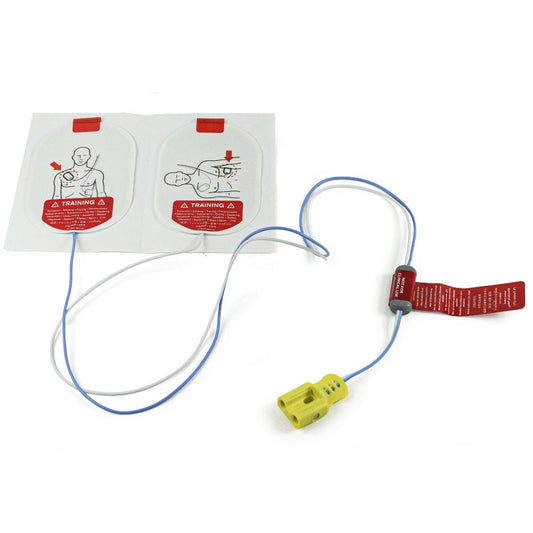
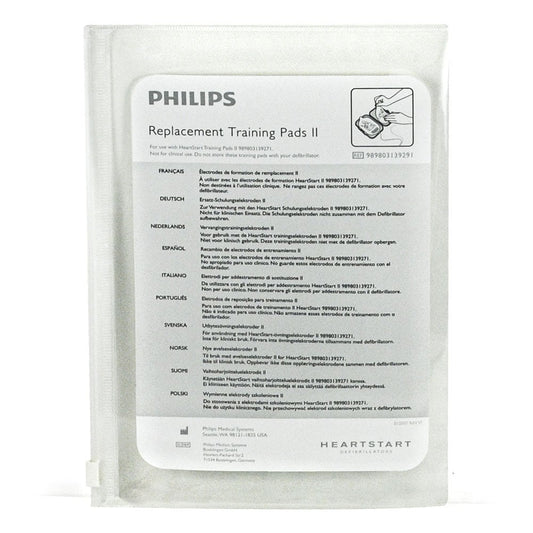
FRx Replacement TRAINING Pads II
<h2><strong>Enhance Training Effectiveness with Philips FRx Reusable Training Pads</strong></h2> <p>Unleash the full potential of your training sessions with the Philips FRx Reusable Training Pads, meticulously designed for optimal CPR and AED instruction. Crafted for repeated use, these training pads simulate real-life scenarios, fostering a hands-on and immersive learning experience.</p> <p><strong>Key Features:</strong></p> <ul> <li> <strong>Reusable Design:</strong> Durable construction for multiple training sessions, maximizing cost-effectiveness.</li> <li> <strong>Realistic Simulation:</strong> Mimics the FRx electrode pads' feel and function, providing lifelike training scenarios.</li> <li> <strong>Complete Set:</strong> Includes wires and plugs for seamless integration with your FRx Trainer.</li> </ul> <p><strong>Advantages of Philips FRx Reusable Training Pads:</strong></p> <ul> <li> <strong>Cost-Efficient Training:</strong> Eliminate the need for frequent pad replacements with reusable design.</li> <li> <strong>Consistent Learning:</strong> Trainees experience authentic pad application, enhancing skill retention.</li> <li> <strong>Comprehensive Compatibility:</strong> Perfectly suited for use with Philips FRx Trainer units.</li> </ul> <p><strong>Easy Integration:</strong></p> <ul> <li> <strong>Plug-and-Play Setup:</strong> Effortless connection with the included wires and plugs.</li> <li> <strong>User-Friendly Operation:</strong> Intuitive design for hassle-free use in training environments.</li> </ul> <p><strong>Why Choose Response Ready:</strong></p> <ul> <li> <strong>AED Training Excellence:</strong> A decade of expertise in providing top-notch AED training solutions.</li> <li> <strong>Quality Assurance:</strong> Our products undergo rigorous testing to ensure reliability and longevity.</li> <li> <strong>Customer Satisfaction:</strong> Dedicated support to meet your training needs effectively.</li> </ul> <p><strong>Upgrade Your Training Experience:</strong> Invest in the Philips FRx Reusable Training Pads from Response Ready to elevate your training sessions. Unleash the power of realistic simulations for a more impactful and hands-on learning journey.</p>
FRx Replacement TRAINING Pads II
view productRegular price $60.00Regular priceUnit price / per -
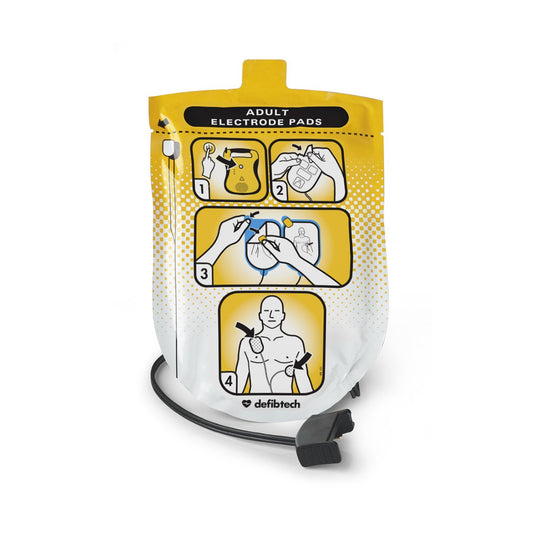
Defibtech Lifeline AED Pads
<h2><strong>Response Ready: Defibtech Lifeline AED Adult Pads</strong></h2> <p><em>Optimize Lifesaving with Defibtech Lifeline AED Adult Pads</em></p> <p><strong>Key Features:</strong></p> <ul> <li> <strong>Critical Support:</strong> Designed for use with the Defibtech Lifeline AED to address sudden cardiac emergencies promptly.</li> <li> <strong>Compatibility Assurance:</strong> Tailored to seamlessly integrate with the Defibtech Lifeline AED model.</li> </ul> <p><strong>Benefits of Defibtech Lifeline AED Adult Pads:</strong></p> <ul> <li> <strong>Versatility:</strong> Suitable for adult patients in cardiac emergencies.</li> <li> <strong>Ease of Use:</strong> Simple application process for quick response.</li> </ul> <p><strong>Why Choose Response Ready?</strong></p> <ul> <li> <strong>Authorized Distributor:</strong> Source your Defibtech Lifeline AED pads from Response Ready, your trusted and authorized distributor.</li> <li> <strong>Emergency Preparedness:</strong> Ensure you have an extra set on hand to stay prepared for unexpected situations.</li> </ul> <p><strong>Enhance Your Lifesaving Capability – Order Defibtech Lifeline AED Adult Pads from Response Ready Today!</strong></p>
Defibtech Lifeline AED Pads
view productRegular price $75.15Regular priceUnit price / per -

Cardiac Science Pediatric TRAINING Electrode Pads
<h2><strong>Elevate Training Simulations with Response Ready Pediatric Training Pads</strong></h2> <p><strong>Key Features:</strong></p> <ol> <li> <strong>Optimized Training Experience:</strong> <ul> <li>Specifically designed for use with the Cardiac Science Training Device.</li> <li>Enhance your training simulations for a realistic pediatric rescue scenario.</li> </ul> </li> <li> <strong>Pediatric Simulations:</strong> <ul> <li>Simulate emergency situations involving pediatric patients during training.</li> <li>Ideal for honing skills in a controlled environment.</li> </ul> </li> <li> <strong>Not for Emergency Use:</strong> <ul> <li>These training pads are strictly for simulation purposes.</li> <li>Ensure compliance with training protocols; they cannot be used in actual emergencies.</li> </ul> </li> <li> <strong>Compatibility:</strong> <ul> <li>Tailored for use with the Powerheart AED G3 Plus model.</li> <li>Seamlessly integrate with your AED training program for comprehensive learning.</li> </ul> </li> <li> <strong>Realistic Training Scenarios:</strong> <ul> <li>Mimic pediatric-specific rescue scenarios for effective training.</li> <li>Prepare responders for a diverse range of potential emergencies.</li> </ul> </li> </ol> <p><strong>Why Choose Response Ready:</strong></p> <ul> <li> <strong>Specialized Training Solutions:</strong> <ul> <li>Response Ready provides training accessories designed for realistic simulations.</li> </ul> </li> <li> <strong>Quality Assurance:</strong> <ul> <li>Trust in the quality and reliability of Response Ready products.</li> </ul> </li> <li> <strong>Comprehensive Training Programs:</strong> <ul> <li>Enhance your training curriculum with dedicated pediatric simulation tools.</li> </ul> </li> </ul> <p><strong>Invest in Effective Training – Order Response Ready Pediatric Training Pads Now!</strong></p> <p>Transform your training sessions with Response Ready Pediatric Training Pads. Crafted for use with the Powerheart AED G3 Plus, these pads ensure a realistic and immersive training experience. Order now for top-notch quality, specialized training solutions, and reliable performance.</p>
Cardiac Science Pediatric TRAINING Electrode Pads
view productRegular price $90.00Regular priceUnit price / per
Shop Every FDA-Approved
AED Machine
Why choose us?
Expert AED recommendations, training, and maintenance. Trusted
relationships with FDA-approved manufacturers.
AED Program Management
Wide range of FDA-approved AEDs and accessories.
Training & Maintenance
Robust training and maintenance programs for AEDs.
Customer Support
Fast shipping and excellent customer service.

Expert Team
Experienced professionals from
non-profit, corporate, and
emergency medicine.
Reliability
Trusted relationships with all six
FDA-approved AED
manufacturers.
AED Program Management
Wide range of FDA-approved AEDs and accessories.
Training & Maintenance
Robust training and maintenance programs for AEDs.
Customer Support
Fast shipping and excellent customer service.
Expert Team
Experienced professionals from
non-profit, corporate, and
emergency medicine.
Reliability
Trusted relationships with all six
FDA-approved AED
manufacturers.
Frequently
Asked Question
INTRODUCTION TO AEDs
AED PRICING
USING AED DEVICES
AED MAINTENANCE
ADDITIONAL AED QUESTIONS
1. What is an Automated External Defibrillator (AED)?
An AED is a portable medical device designed to analyze heart rhythms and deliver an electric shock if necessary to restore a normal heartbeat during sudden cardiac arrest (SCA). It provides clear audio and visual prompts, enabling even untrained bystanders to assist in life-saving efforts.
2. How does an AED function during a cardiac emergency?
Upon activation, the AED assesses the victim's heart rhythm through adhesive pads placed on the chest. If a shockable rhythm is detected, the device instructs the user to deliver a shock or does so automatically, depending on the model. This intervention can be crucial in restoring effective heart activity.
3. Who can operate an AED?
AEDs are designed for use by laypersons with minimal or no training. Their intuitive design, coupled with step-by-step instructions, ensures that individuals can respond effectively during emergencies. Nonetheless, formal training can enhance confidence and proficiency.
4. Where are AEDs typically located?
AEDs are commonly installed in public areas with high foot traffic, such as airports, schools, shopping centers, and sports facilities. Their strategic placement aims to provide rapid access during cardiac emergencies.
5. Why is timely use of an AED critical?
In cases of SCA, each minute without defibrillation decreases the chance of survival by approximately 10%. Immediate use of an AED, combined with CPR, significantly enhances survival rates and outcomes.
1. What is the typical cost range for an AED?
AED prices vary based on features and brands, generally ranging from $1,200 to $2,500. Advanced models with features like real-time CPR feedback may be at the higher end of this spectrum.
2. What factors influence AED pricing?
Key determinants include the device's features (e.g., semi-automatic vs. fully automatic), brand reputation, warranty length, and included accessories such as carrying cases or spare pads.
3. Are there ongoing costs associated with AED ownership?
Yes, maintenance costs include periodic replacement of batteries and electrode pads, typically every 2 to 5 years, depending on the model. Additionally, some organizations opt for service plans or training programs, which incur additional expenses.
4. Is leasing an AED a viable option?
Leasing can be a cost-effective alternative, especially for organizations with budget constraints. Lease agreements often include maintenance and training services, ensuring the device remains operational and staff are prepared.
5. Do non-profit organizations receive discounts on AEDs?
Many AED suppliers offer special pricing or grant opportunities for non-profits, schools, and community organizations to facilitate broader access to these life-saving devices.
1. What are the steps to use an AED during an emergency?
First, ensure the scene is safe and check the victim for responsiveness. Call emergency services and begin CPR if necessary. Once the AED is available, turn it on, follow the voice prompts to attach the pads, and deliver a shock if advised. Continue CPR until professional help arrives.
2. Can an AED be used on children?
Yes, AEDs can be used on children. For children under 8 years old or weighing less than 55 pounds (25 kg), pediatric pads are recommended. If pediatric pads are unavailable, adult pads can be used as a substitute.
3. Is it safe to use an AED on a wet or metal surface?
While it's preferable to move the victim to a dry area, if that's not possible, ensure the chest is dry before pad application. Avoid direct contact with metal surfaces during shock delivery to minimize the risk of electrical conduction.
4. What if the victim has a pacemaker or implantable device?
AED pads should be placed at least one inch away from any implanted device. The AED will still function effectively without interfering with the implant.
5. Should CPR be continued after using an AED?
Yes, after delivering a shock, resume CPR immediately as instructed by the AED. Continue until emergency medical services take over or the victim shows signs of recovery.
1. How often should an AED be inspected?
Regular inspections, typically monthly, are essential to ensure the AED is operational. Check the status indicator, battery life, and pad expiration dates during each inspection.
2. What components require regular replacement?
The primary consumables are the battery and electrode pads. Their lifespan varies by manufacturer but generally ranges from 2 to 5 years. Always adhere to the manufacturer's guidelines for replacements.
3. How should an AED be stored?
Store the AED in a visible, accessible location with appropriate signage. Ensure it's protected from extreme temperatures and moisture, and that the storage cabinet is free from obstructions.
4. Do AEDs perform self-tests?
Most modern AEDs conduct regular self-tests and display their status via indicators. However, manual inspections are still recommended to verify readiness.
5. Is professional servicing required for AEDs?
While AEDs are designed for minimal maintenance, periodic professional checks can ensure compliance with local regulations and optimal device performance.
What does AED stand for?
AED stands for “automated external defibrillator.” It’s a portable medical device that’s used to assist sudden cardiac arrest (SCA) sufferers. The device analyzes the victim’s heart rhythm and can then deliver an electric shock to the heart if necessary.
Where can you find an AED device?
AED stands for “automated external defibrillator.” It’s a portable medical device that’s used to assist sudden cardiac arrest (SCA) sufferers. The device analyzes the victim’s heart rhythm and can then deliver an electric shock to the heart if necessary.
Can an untrained person use an AED?
AED stands for “automated external defibrillator.” It’s a portable medical device that’s used to assist sudden cardiac arrest (SCA) sufferers. The device analyzes the victim’s heart rhythm and can then deliver an electric shock to the heart if necessary.
What is an AED kit?
AED stands for “automated external defibrillator.” It’s a portable medical device that’s used to assist sudden cardiac arrest (SCA) sufferers. The device analyzes the victim’s heart rhythm and can then deliver an electric shock to the heart if necessary.
Our family of brands
CPR 1
CPR1 is dedicated to delivering high-quality CPR and AED training programs tailored for businesses and organizations. With a team of experienced instructors, CPR1 offers engaging, hands-on training...
Learn moreAED Leader
AED Leader is a premier provider of automated external defibrillators (AEDs) and accessories, dedicated to enhancing cardiac emergency preparedness across various sectors. Established in 2007 and h...
Learn moreAED Total Solution
AED Total Solution specializes in comprehensive AED program management services, aiming to simplify compliance and enhance emergency readiness for organizations. Founded in 2014 by first responders...
Learn more
MDSI
MD Solutions International (MDSI) is a leading provider of medical oversight and program support services for AED implementations across corporate and public sectors. Established in 1997, MDSI offe...
Learn more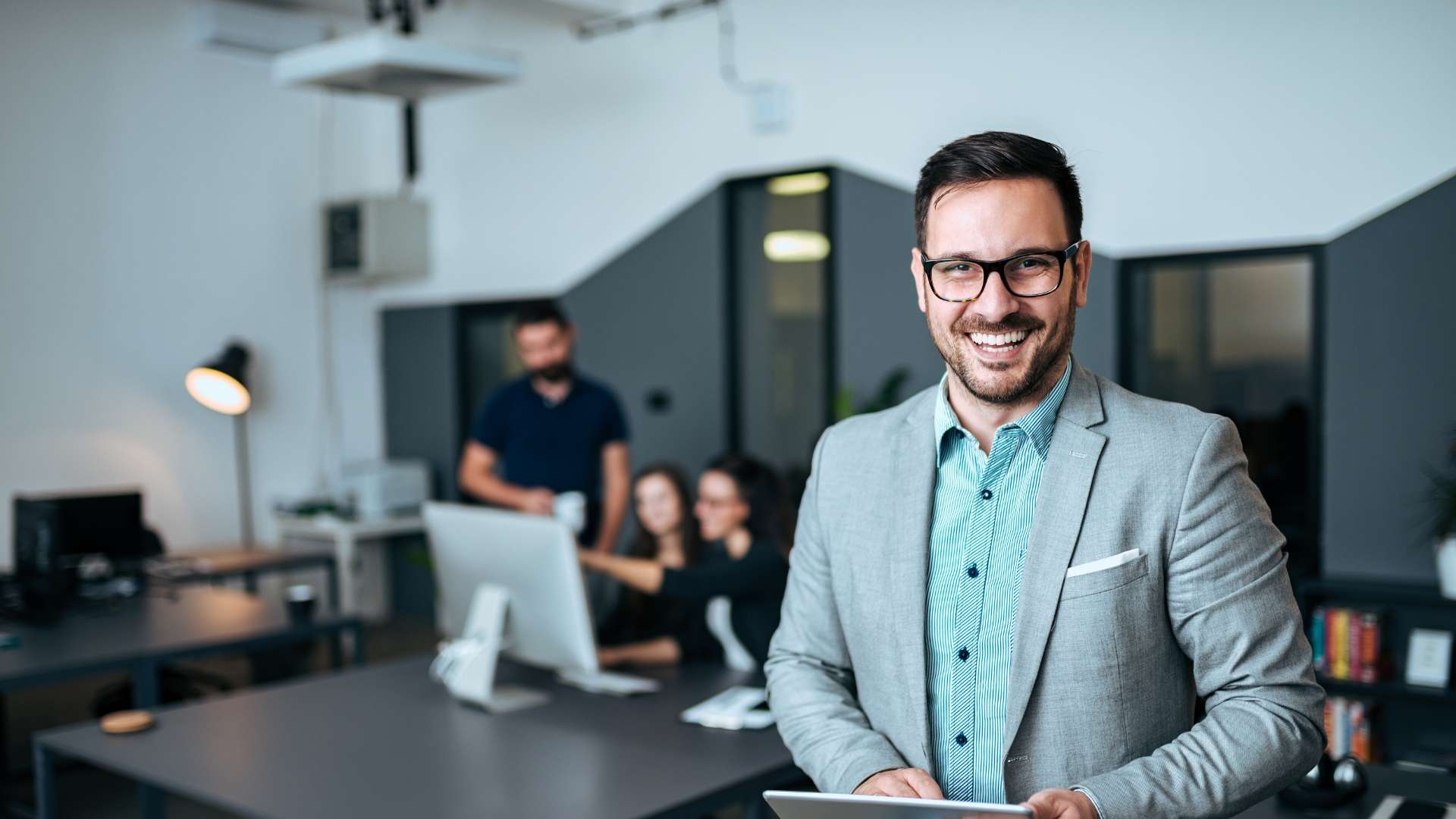
SHOP FOR AEDs, BATTERIES, PADS AND FIRST AID SUPPLIES
Discover the right AED that fits your needs.

